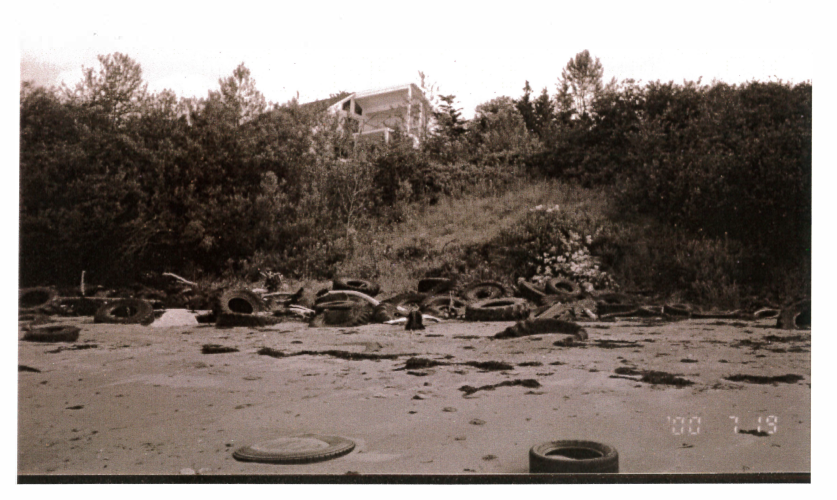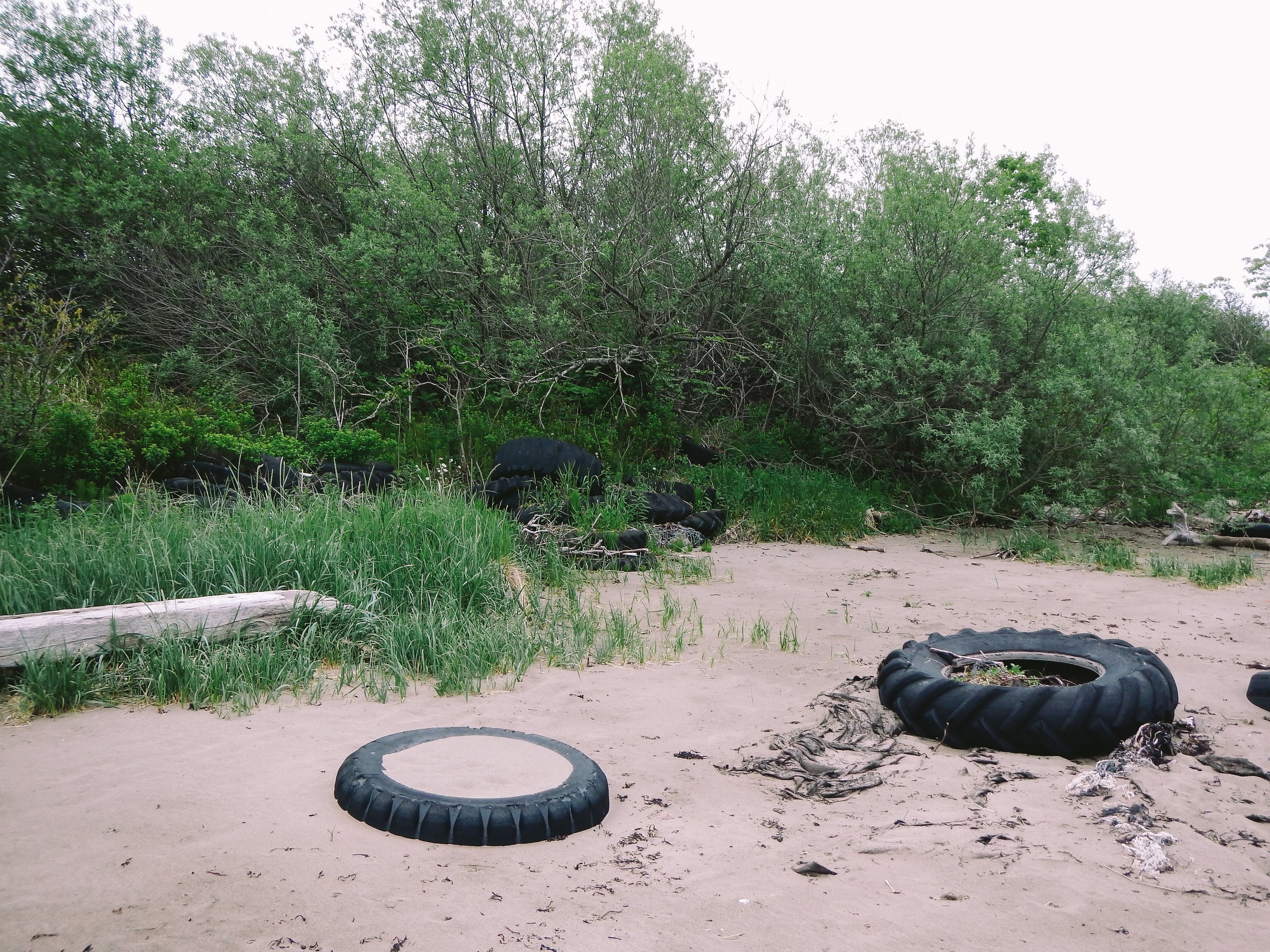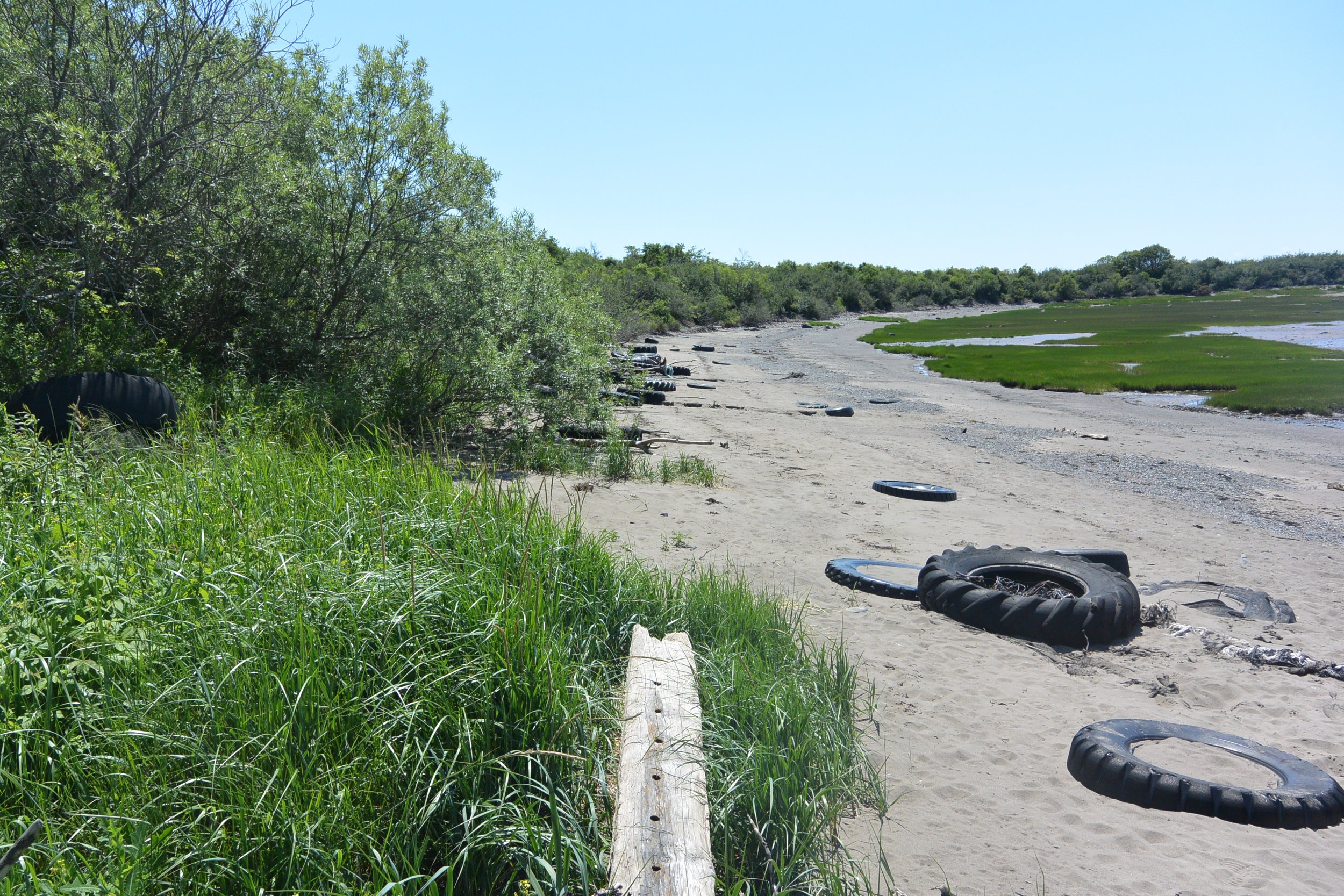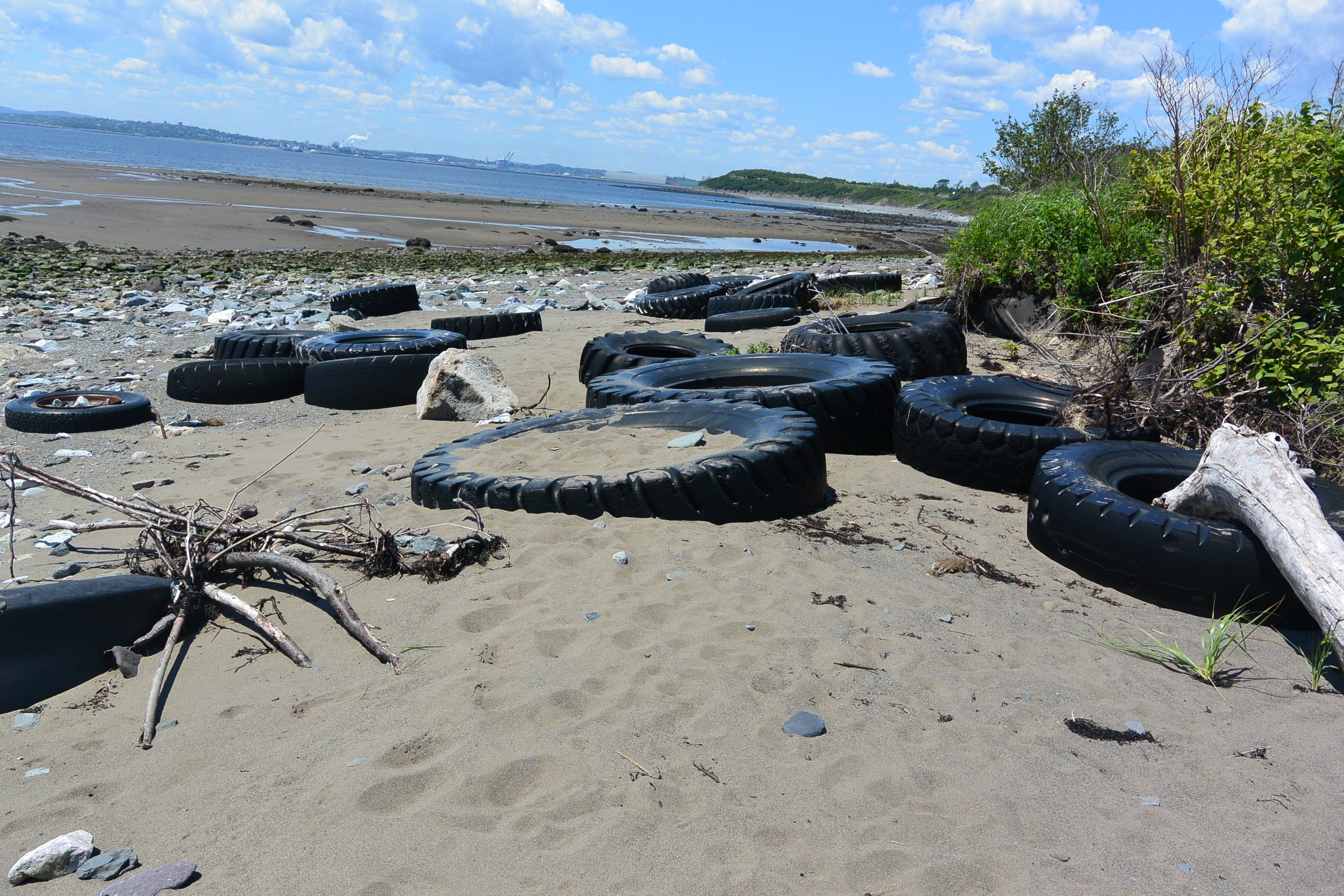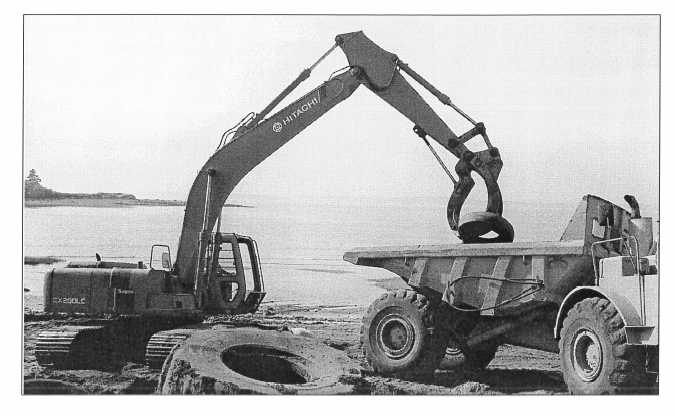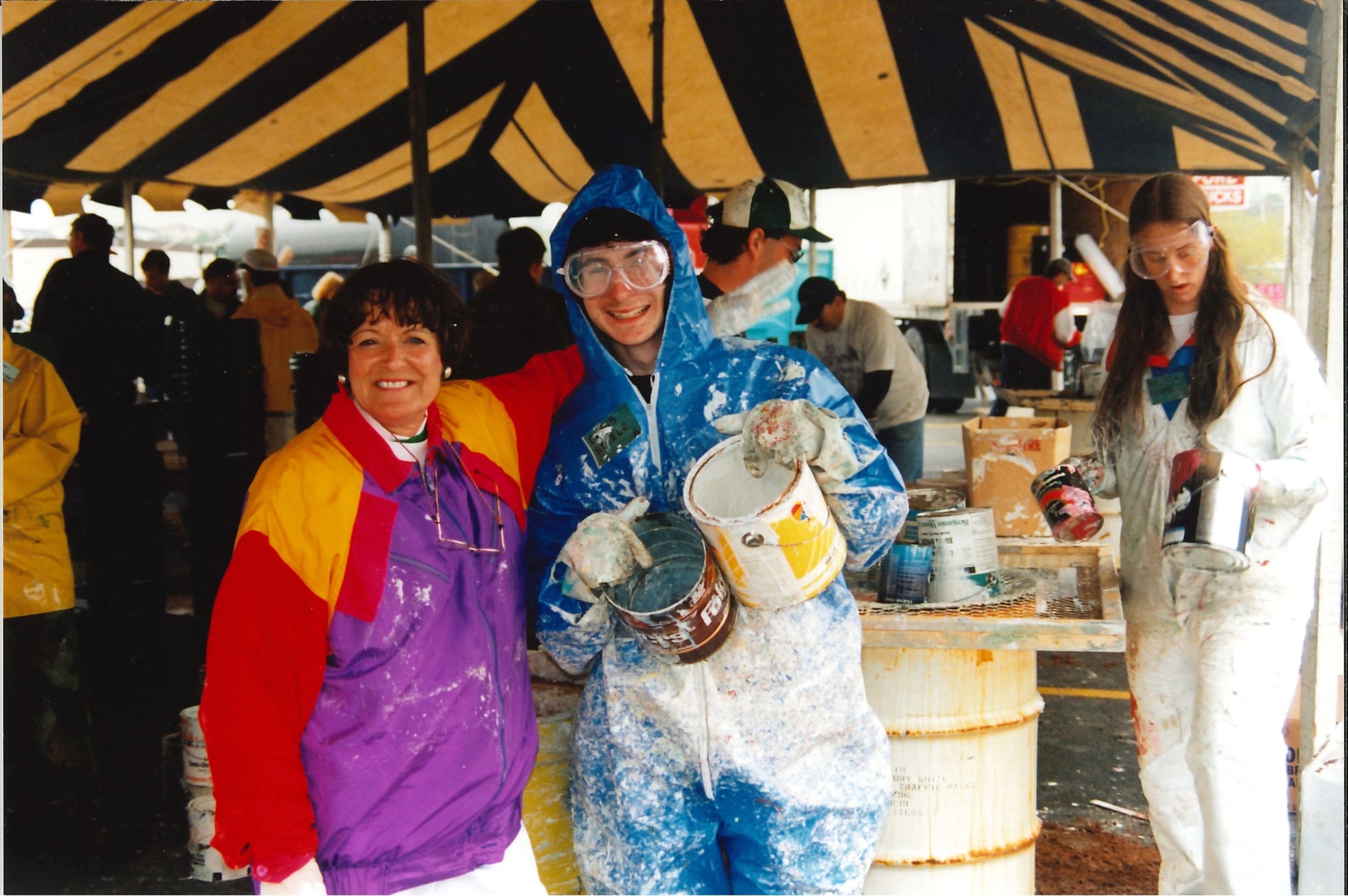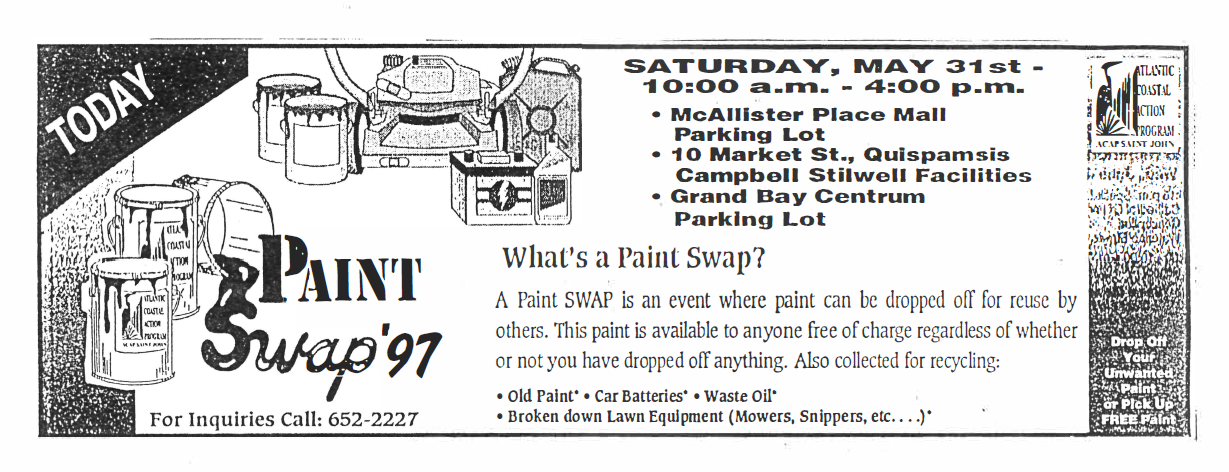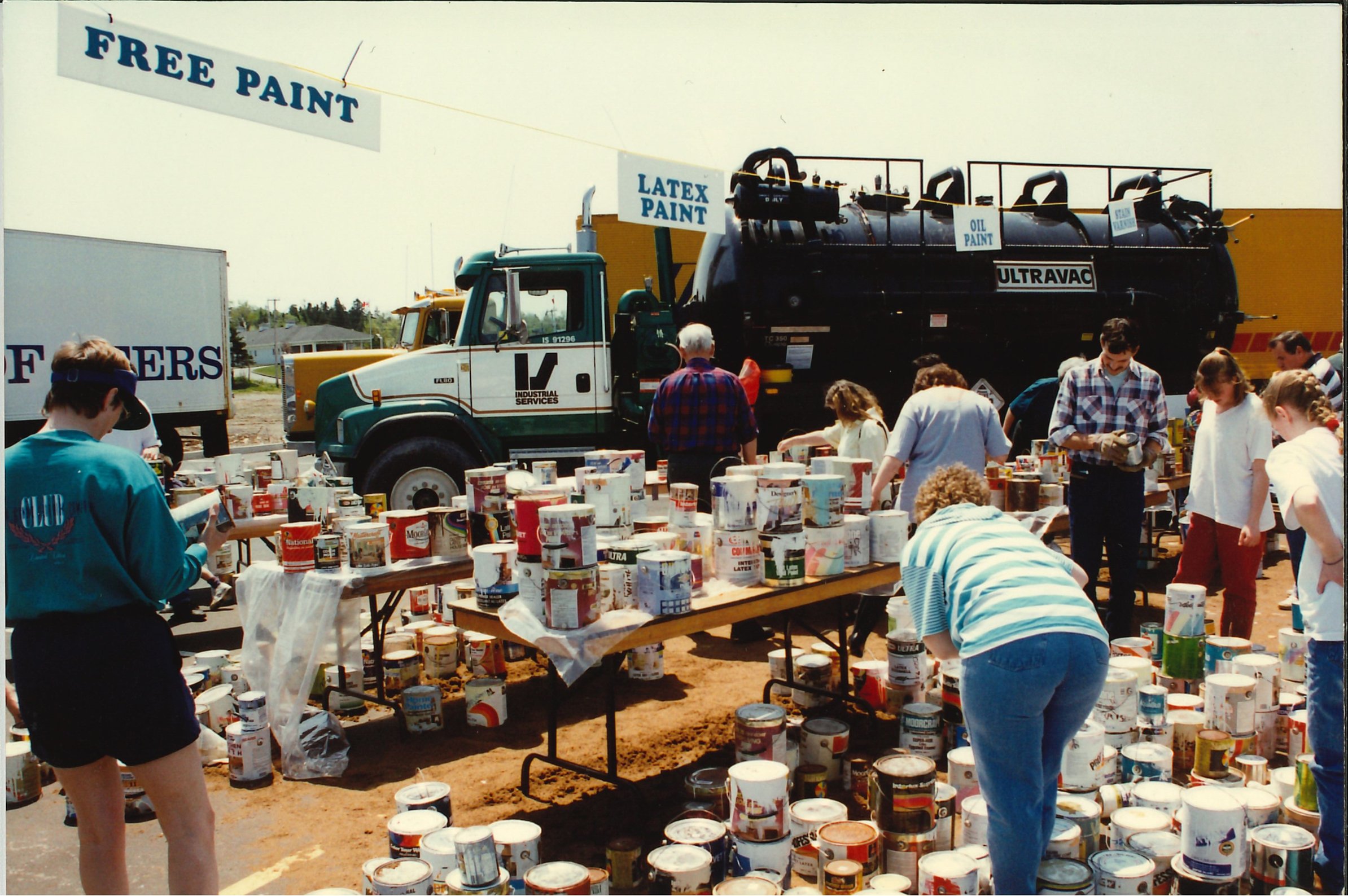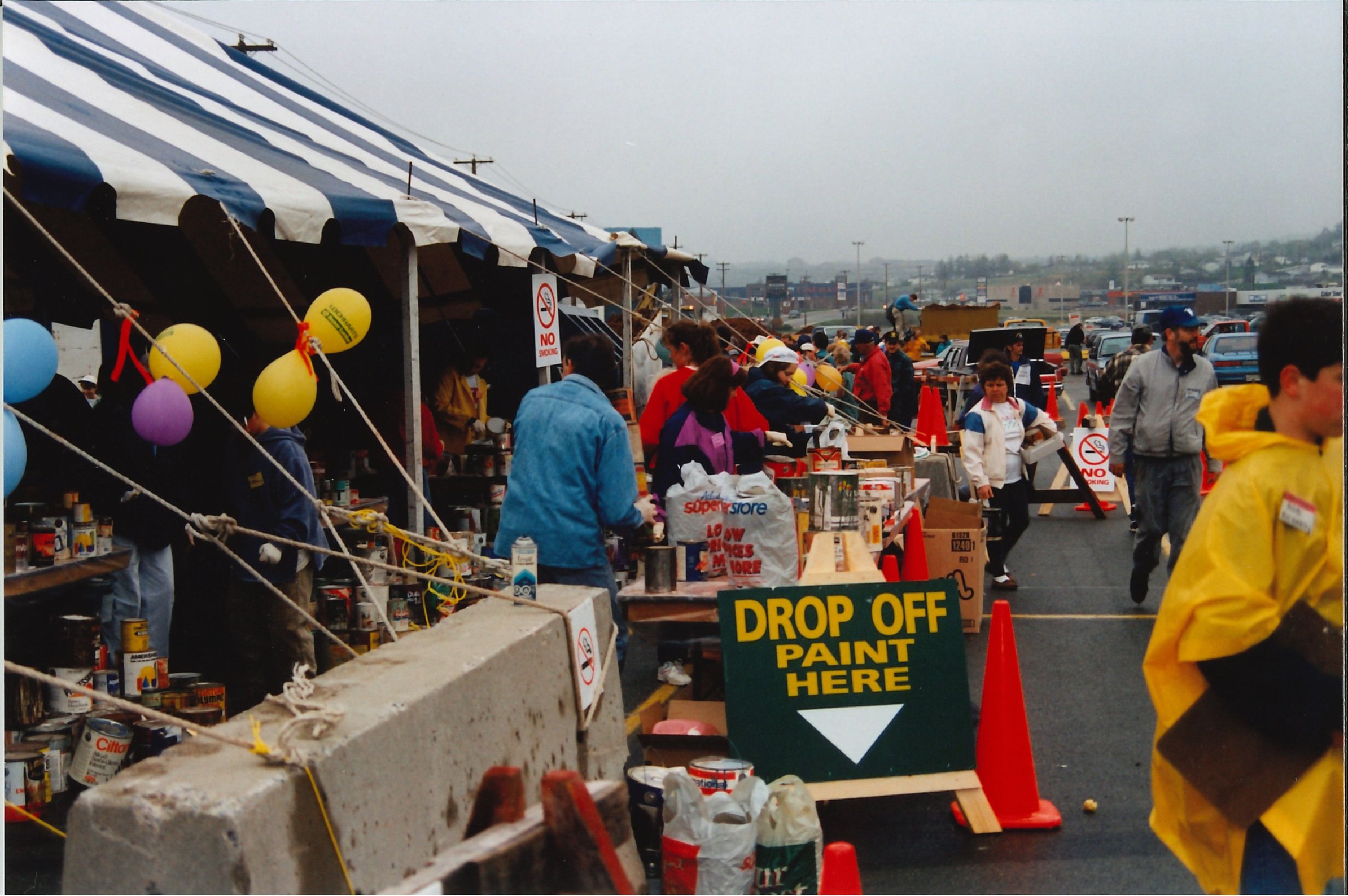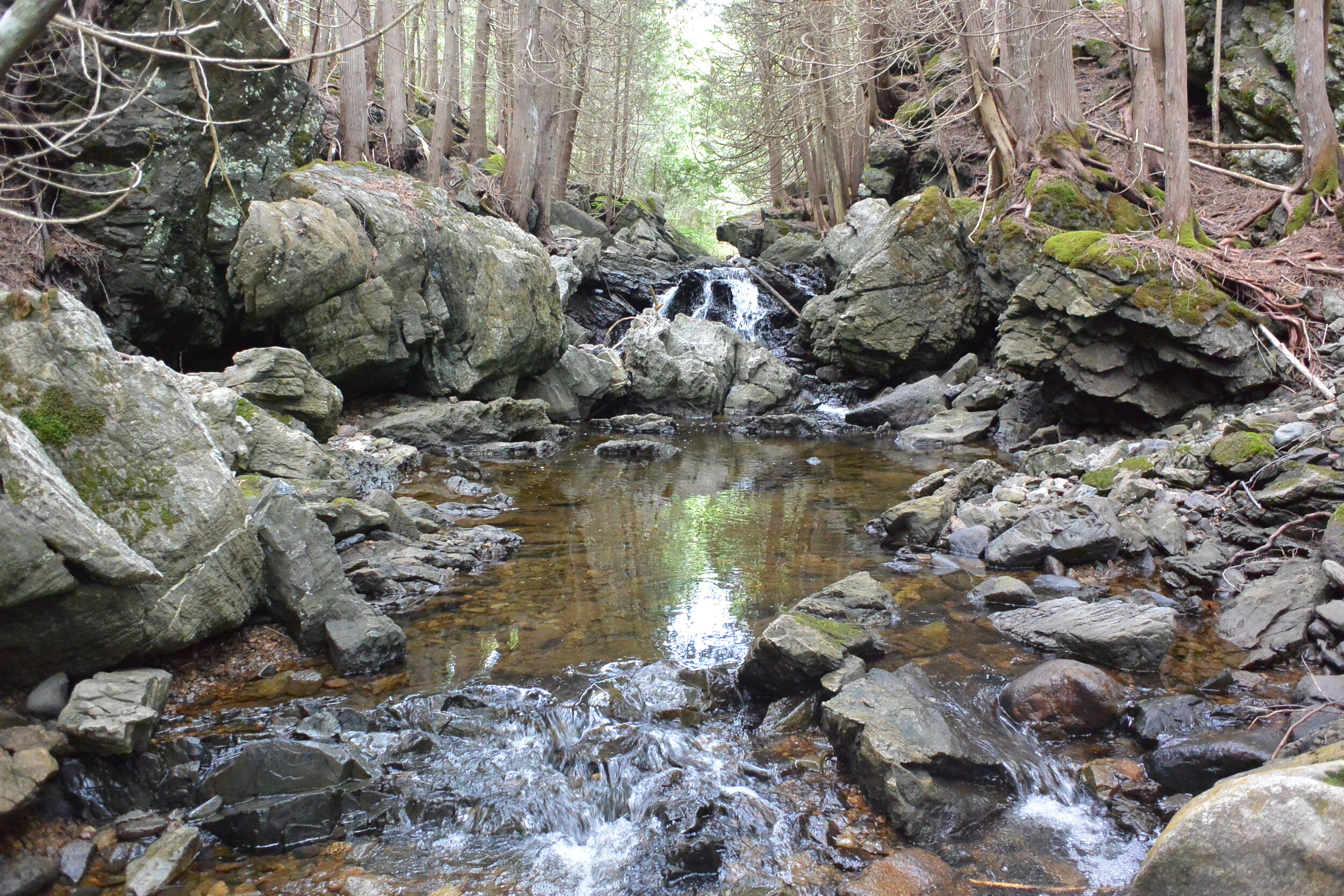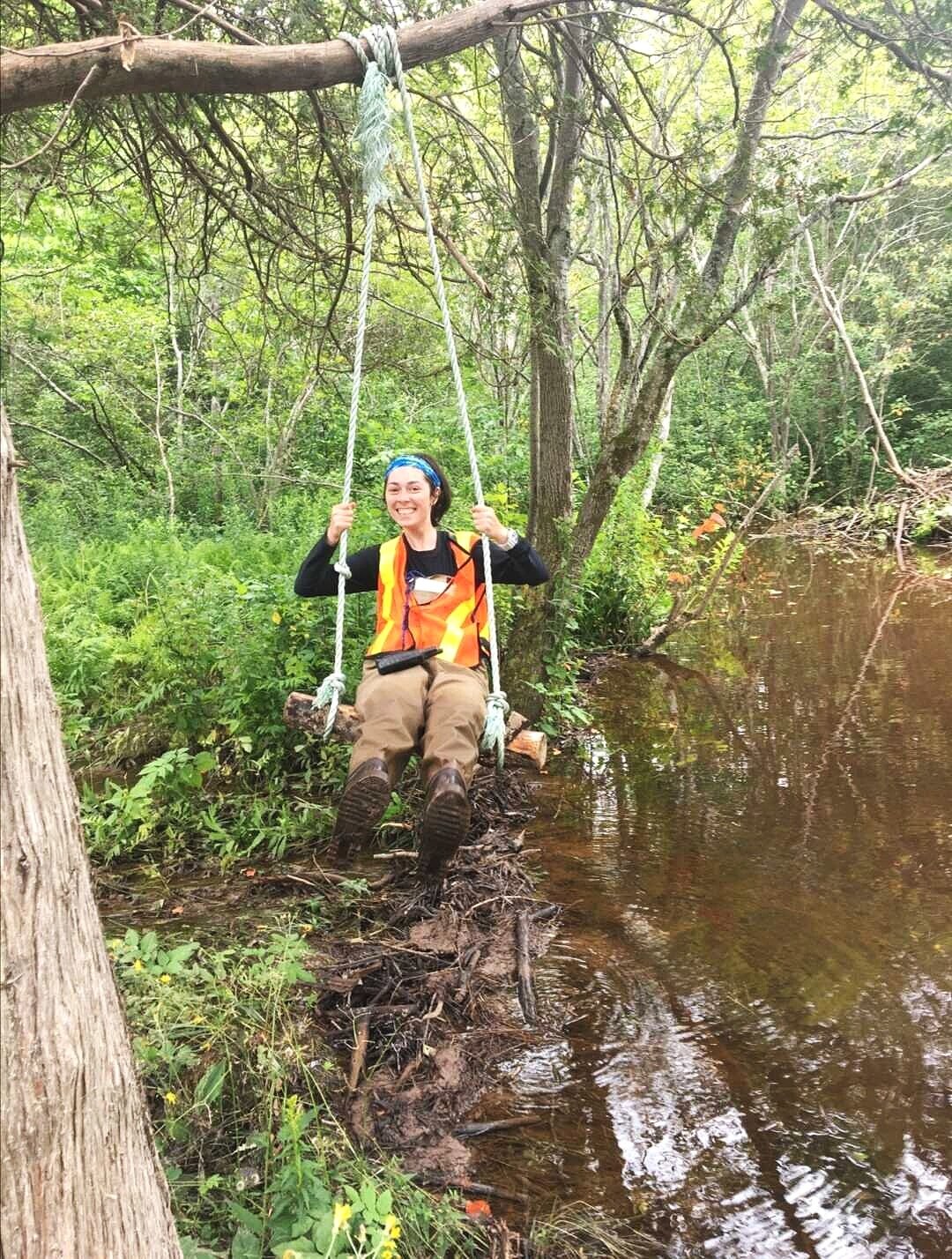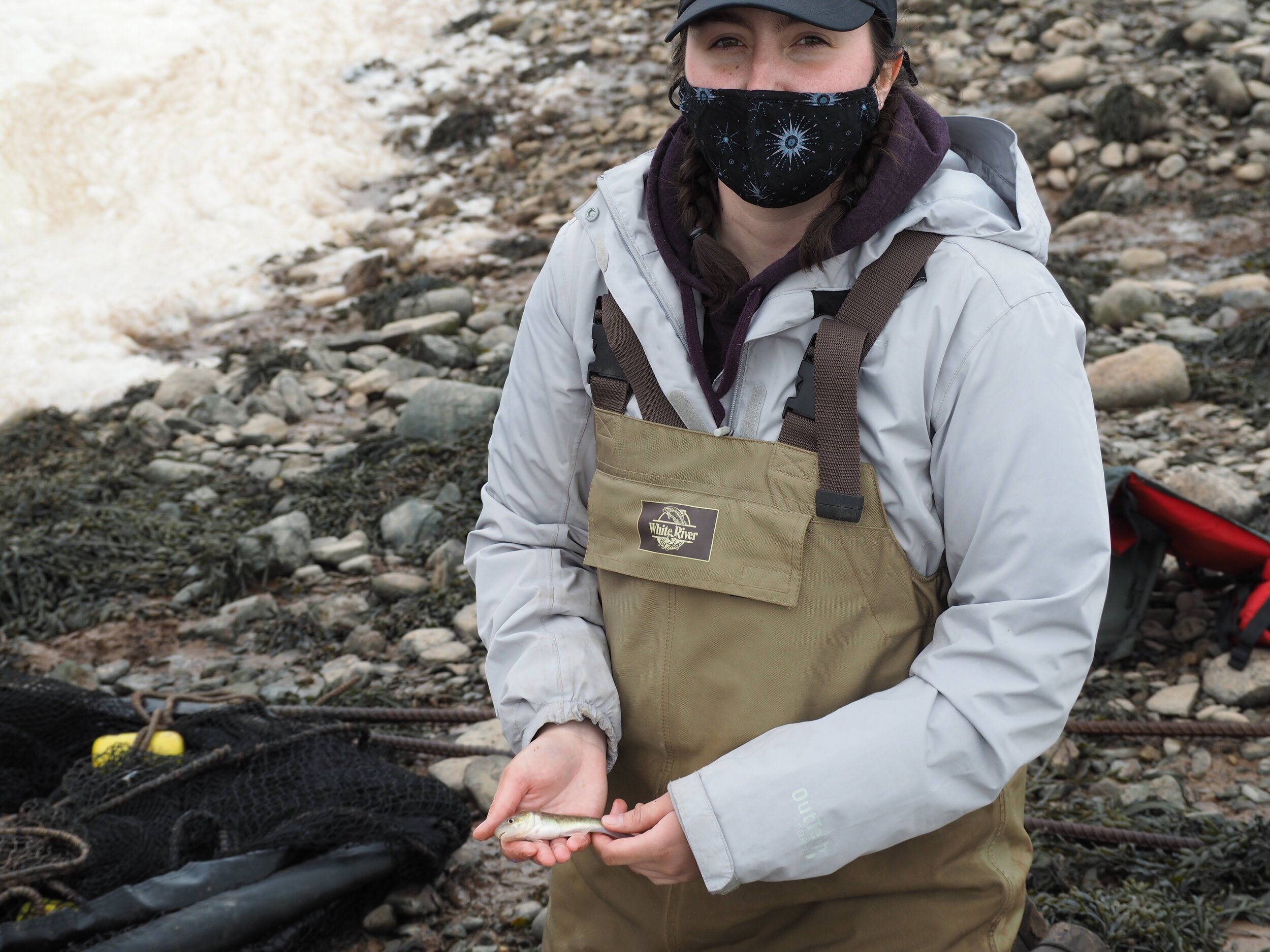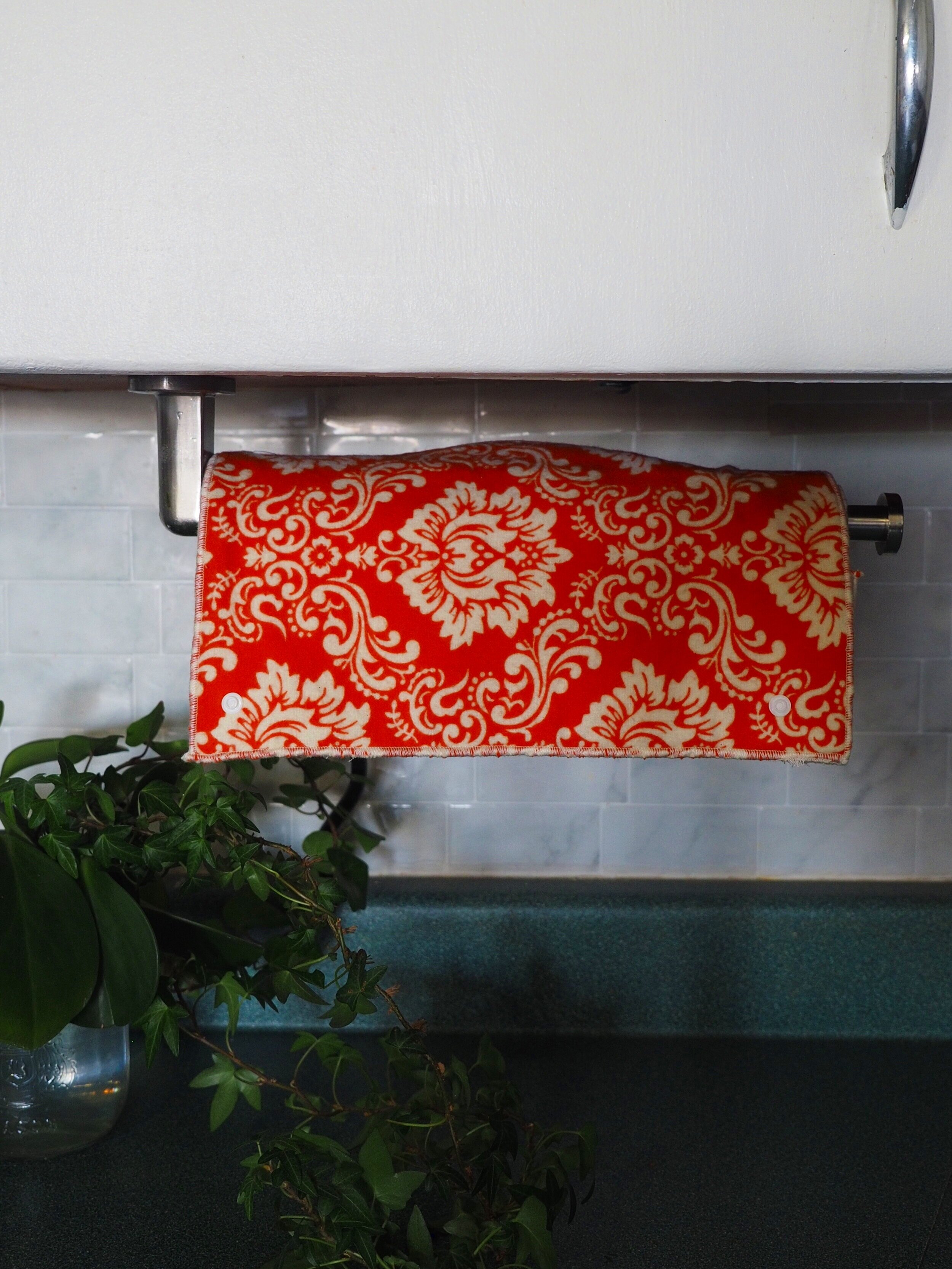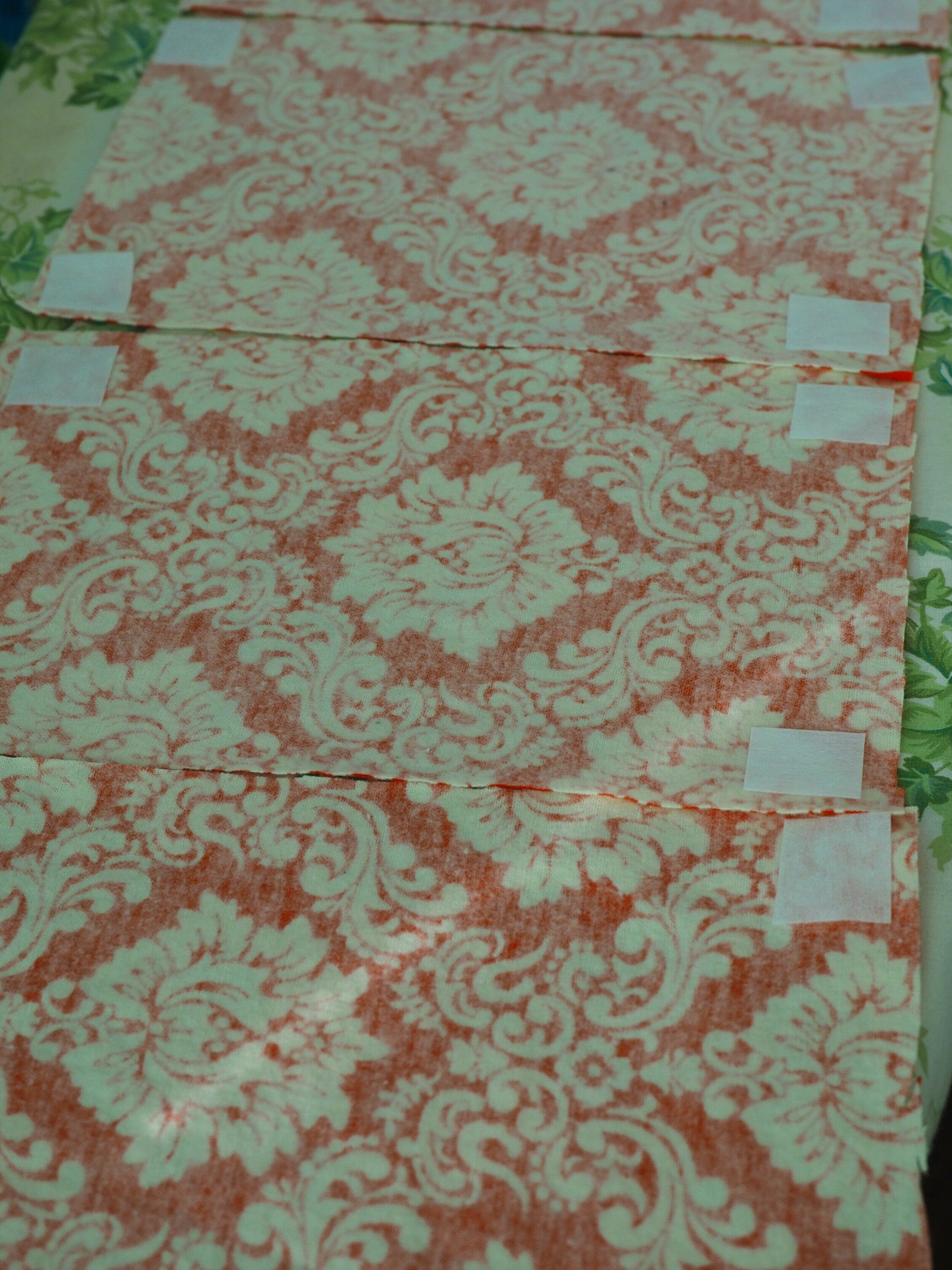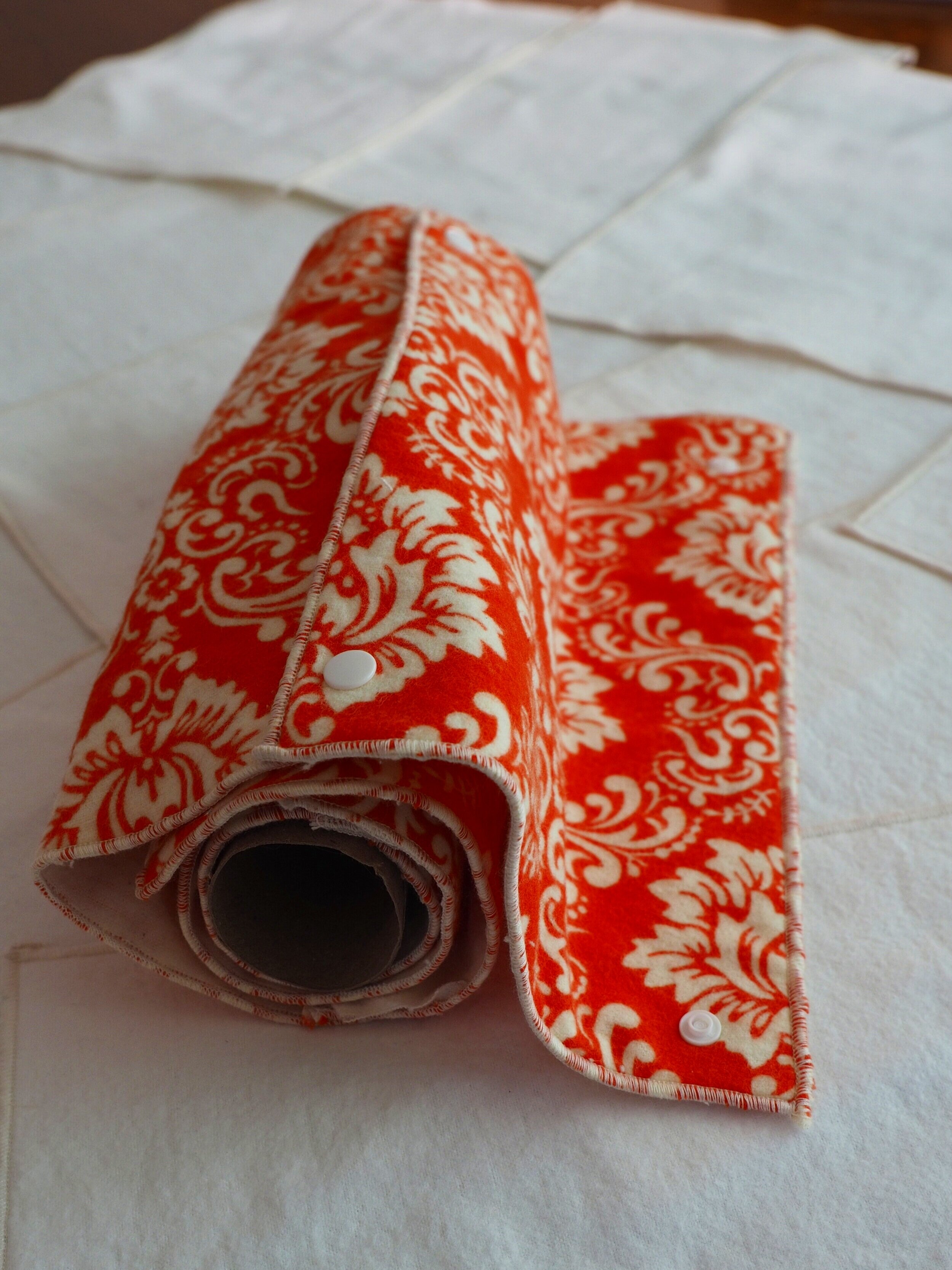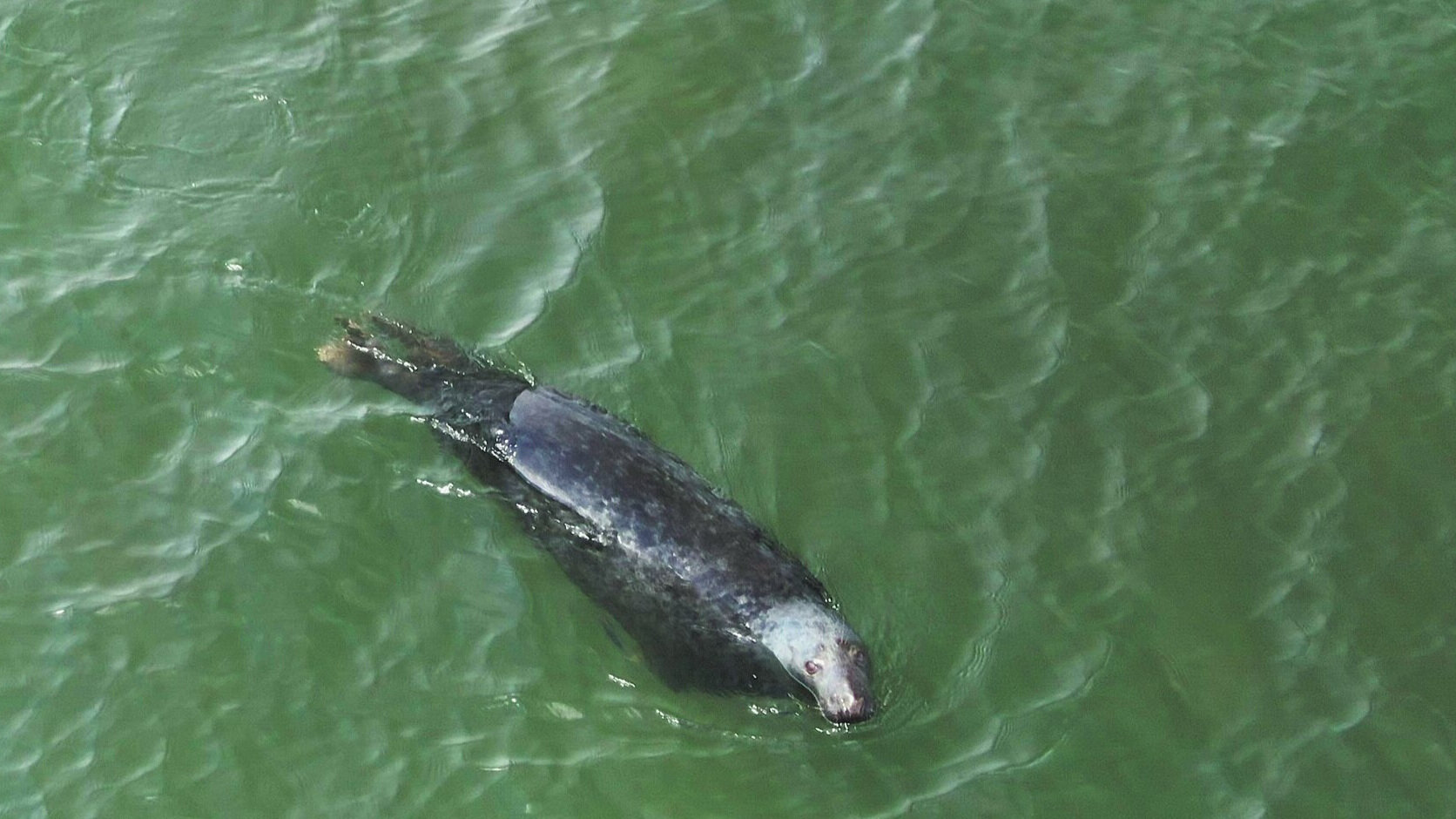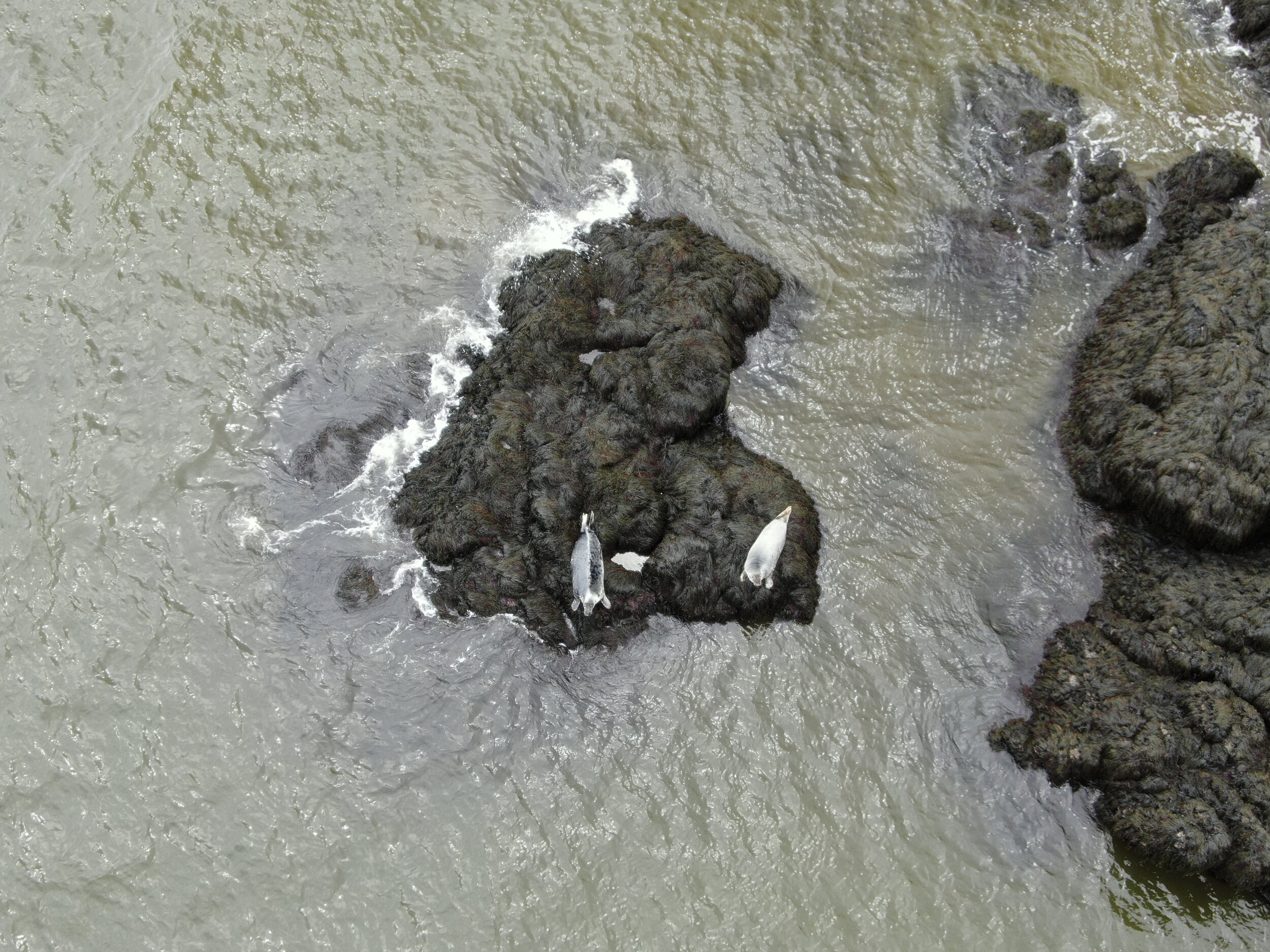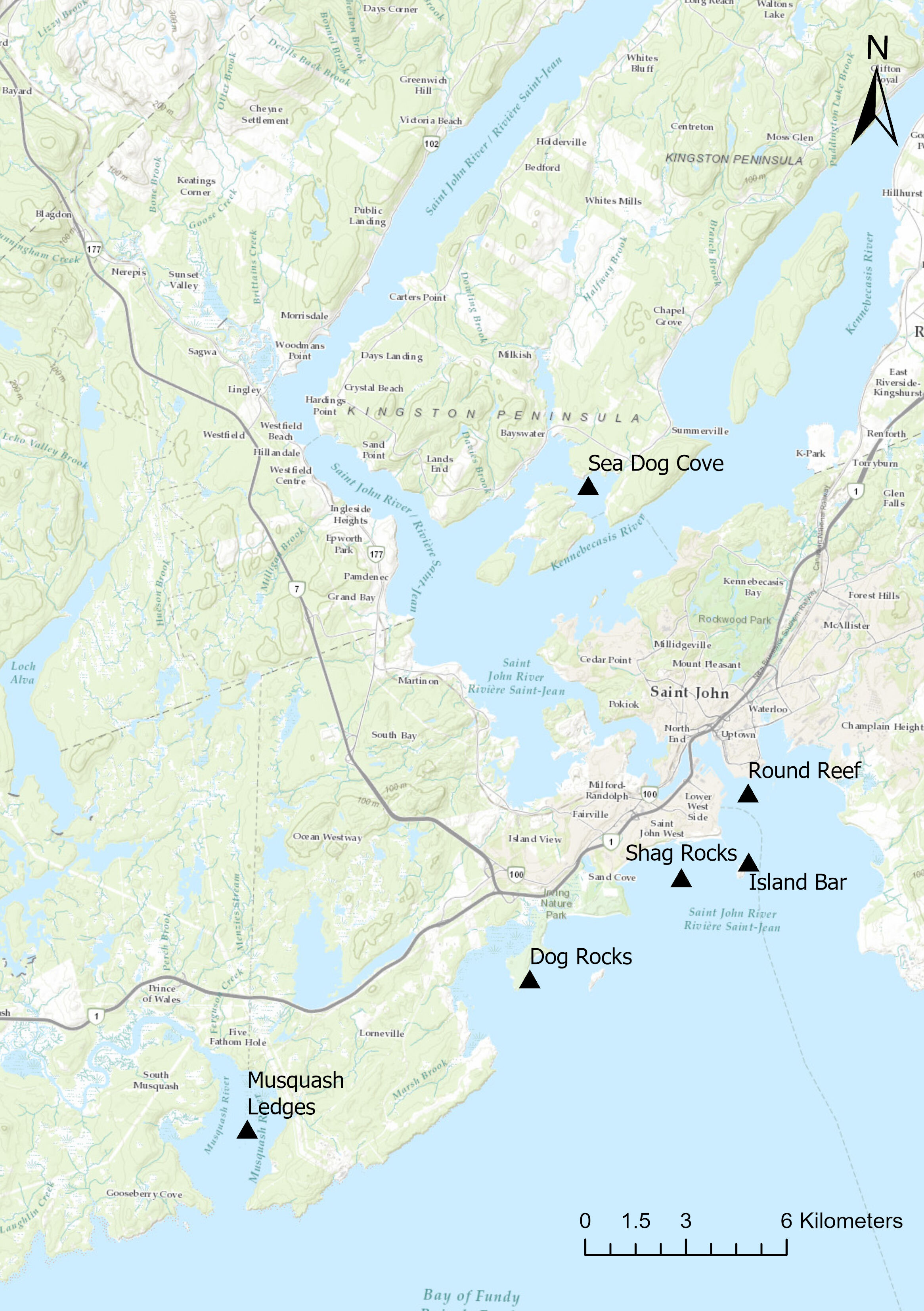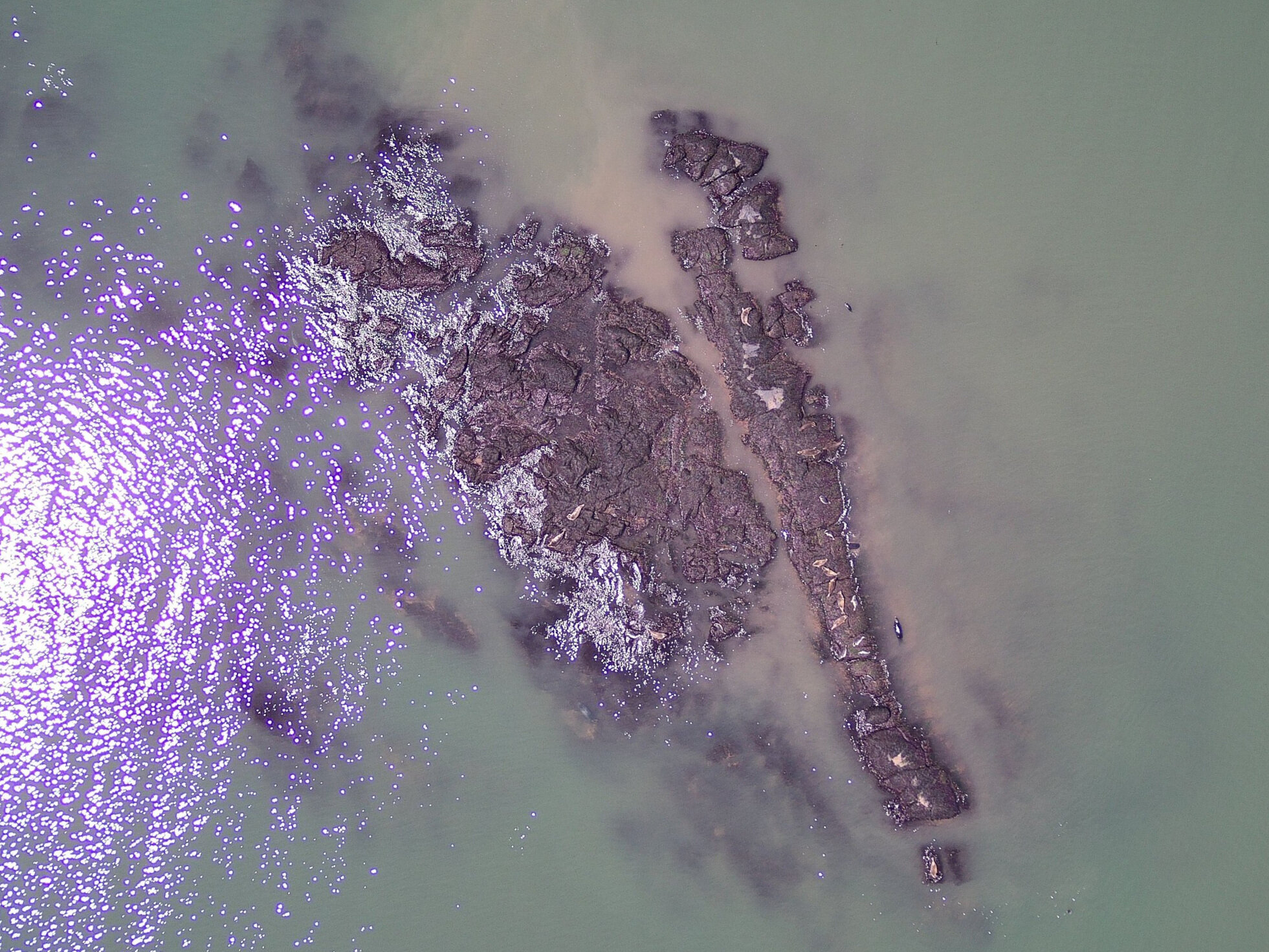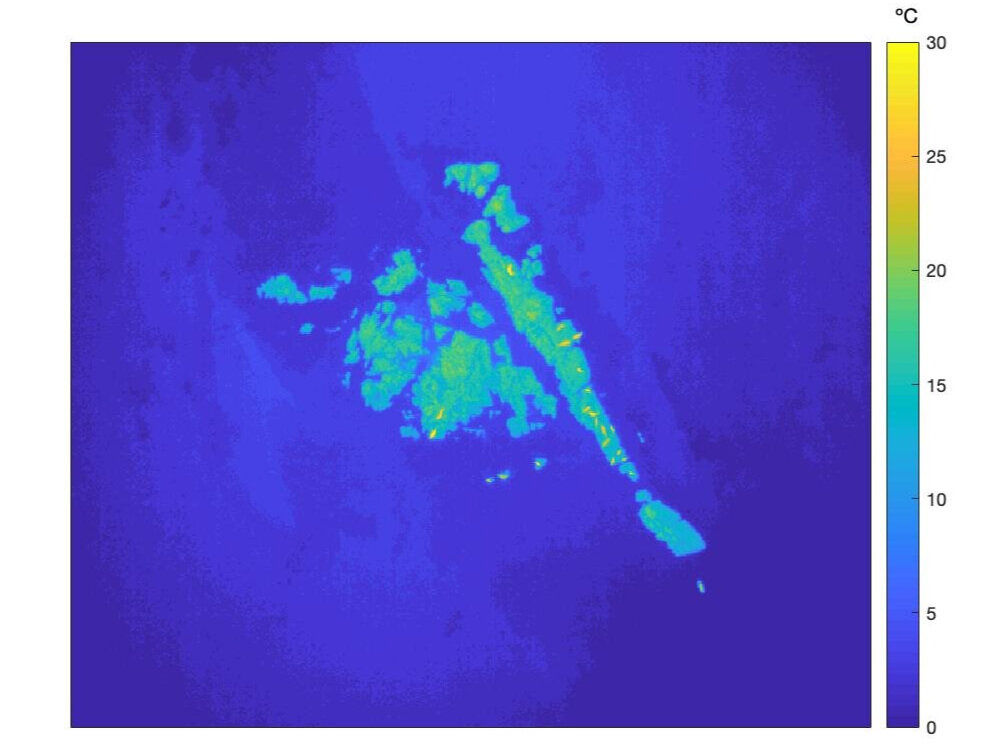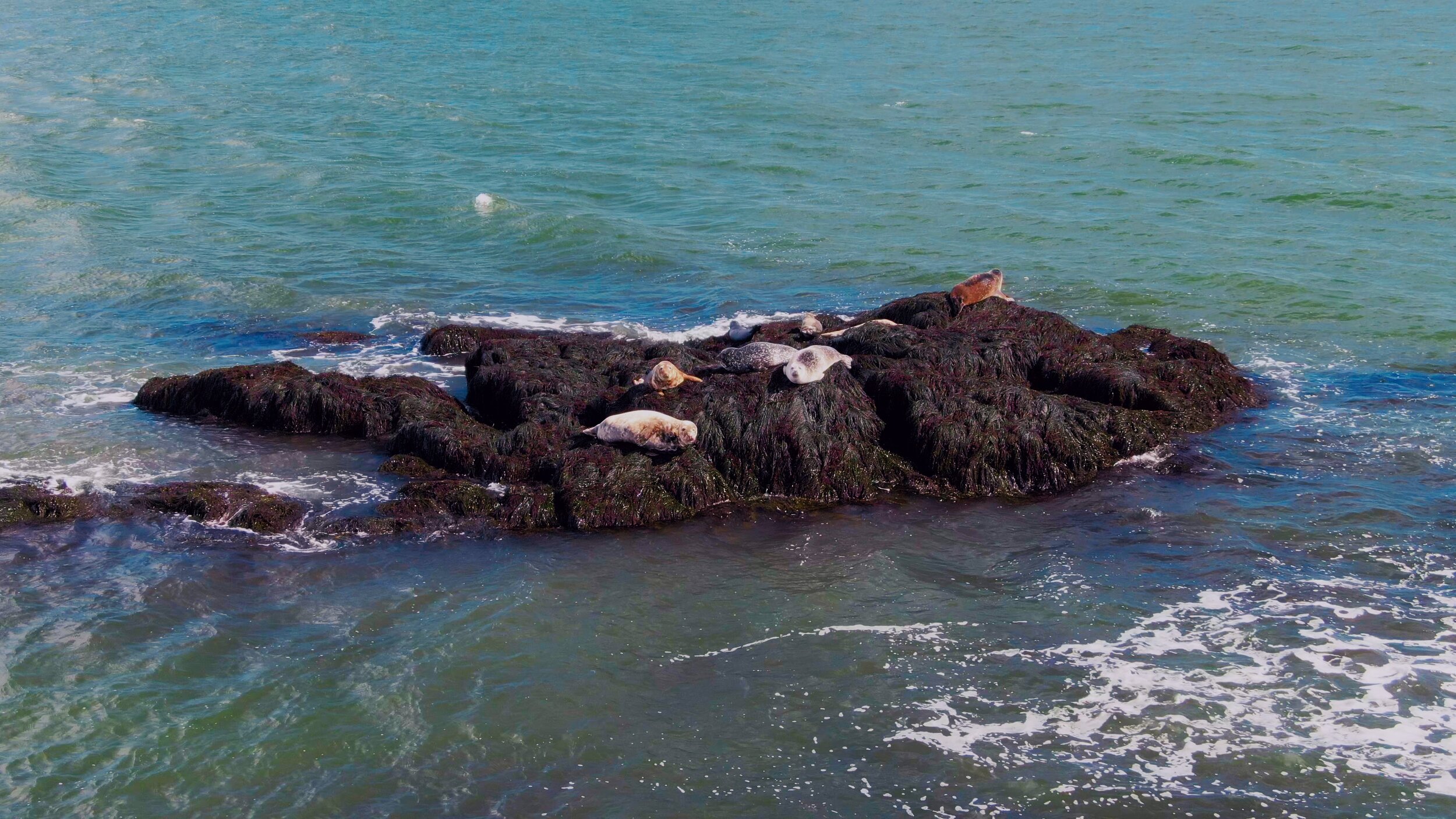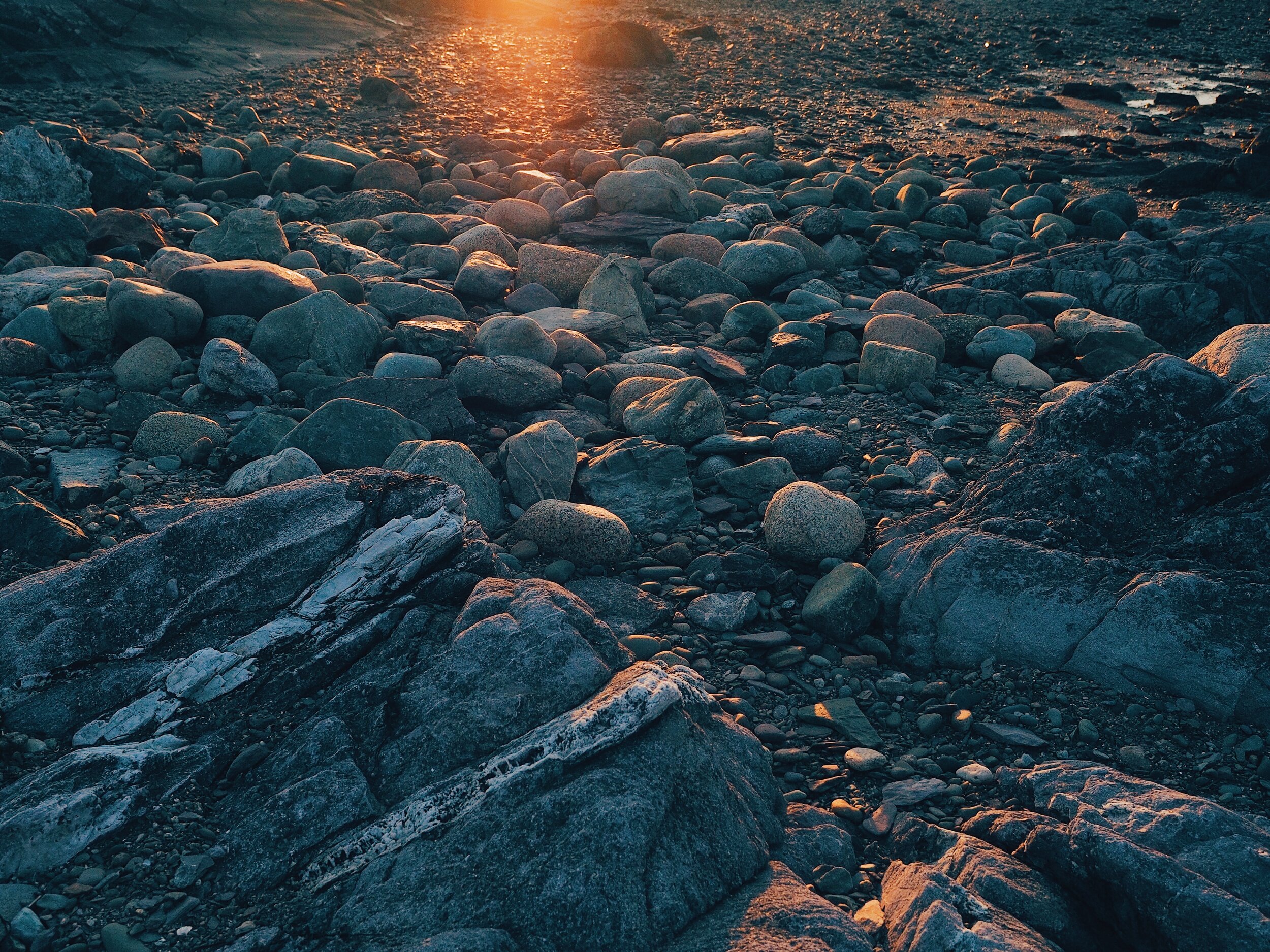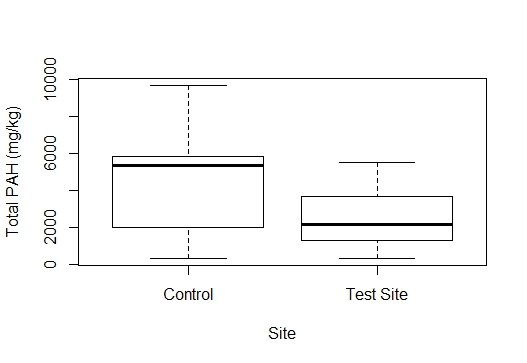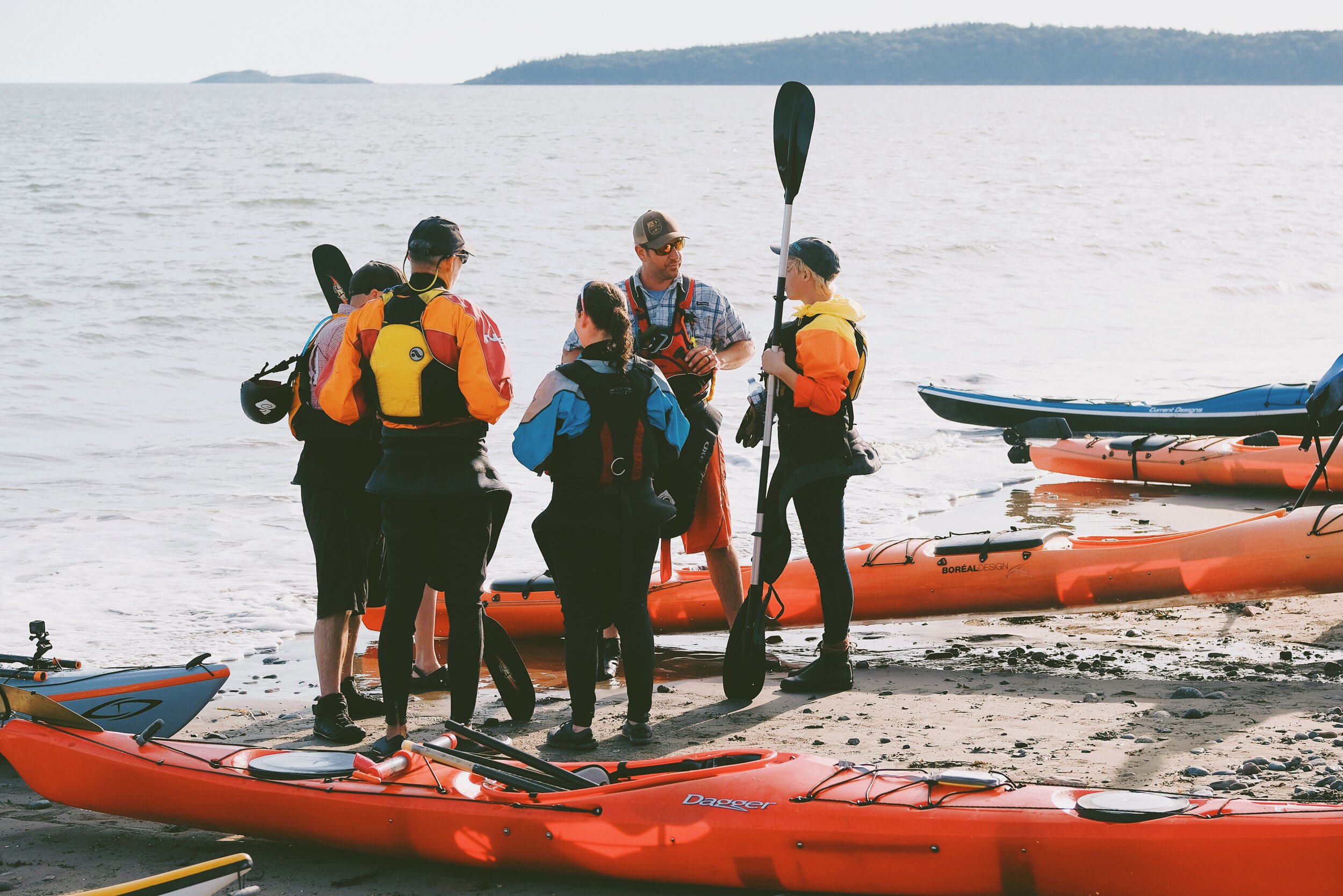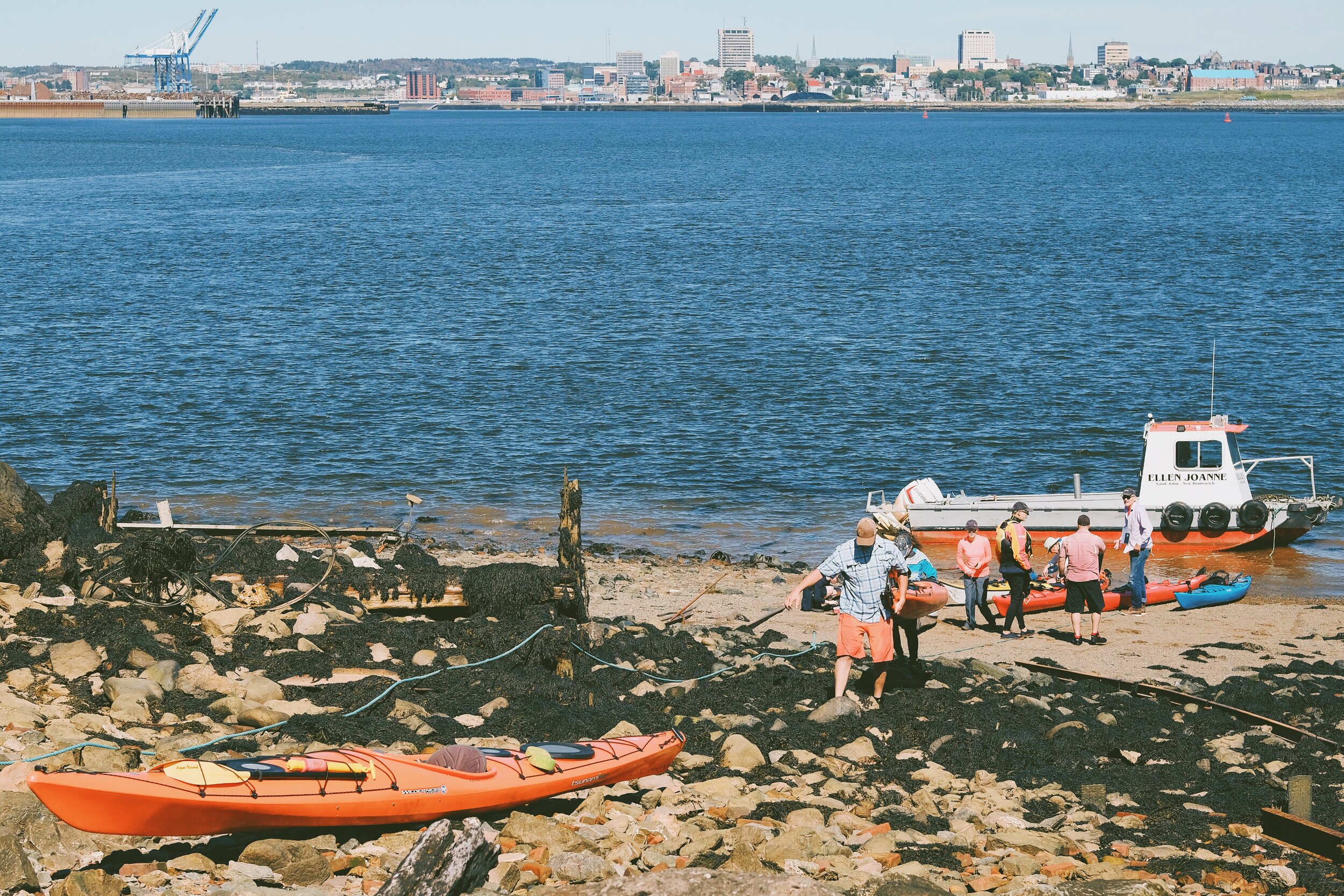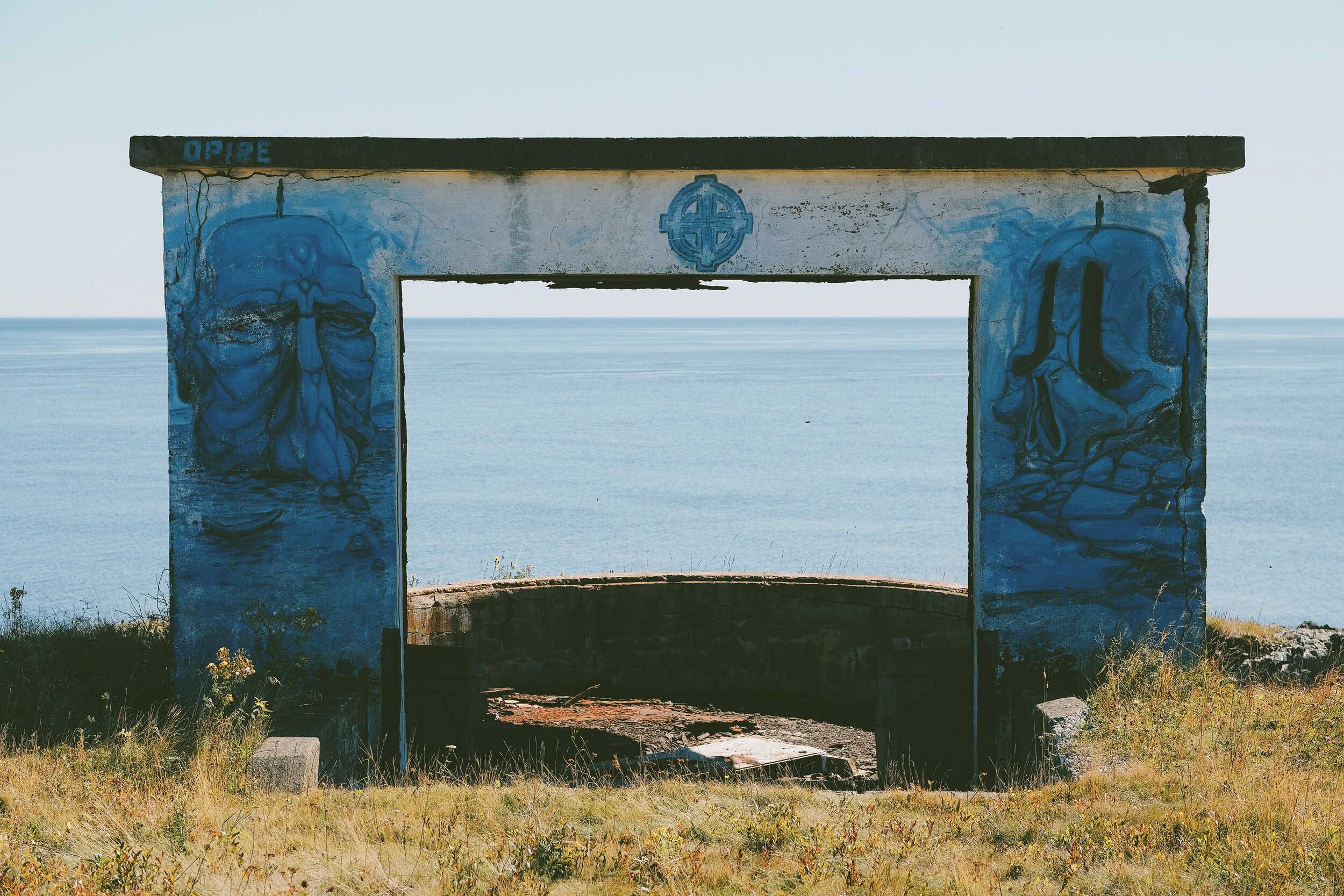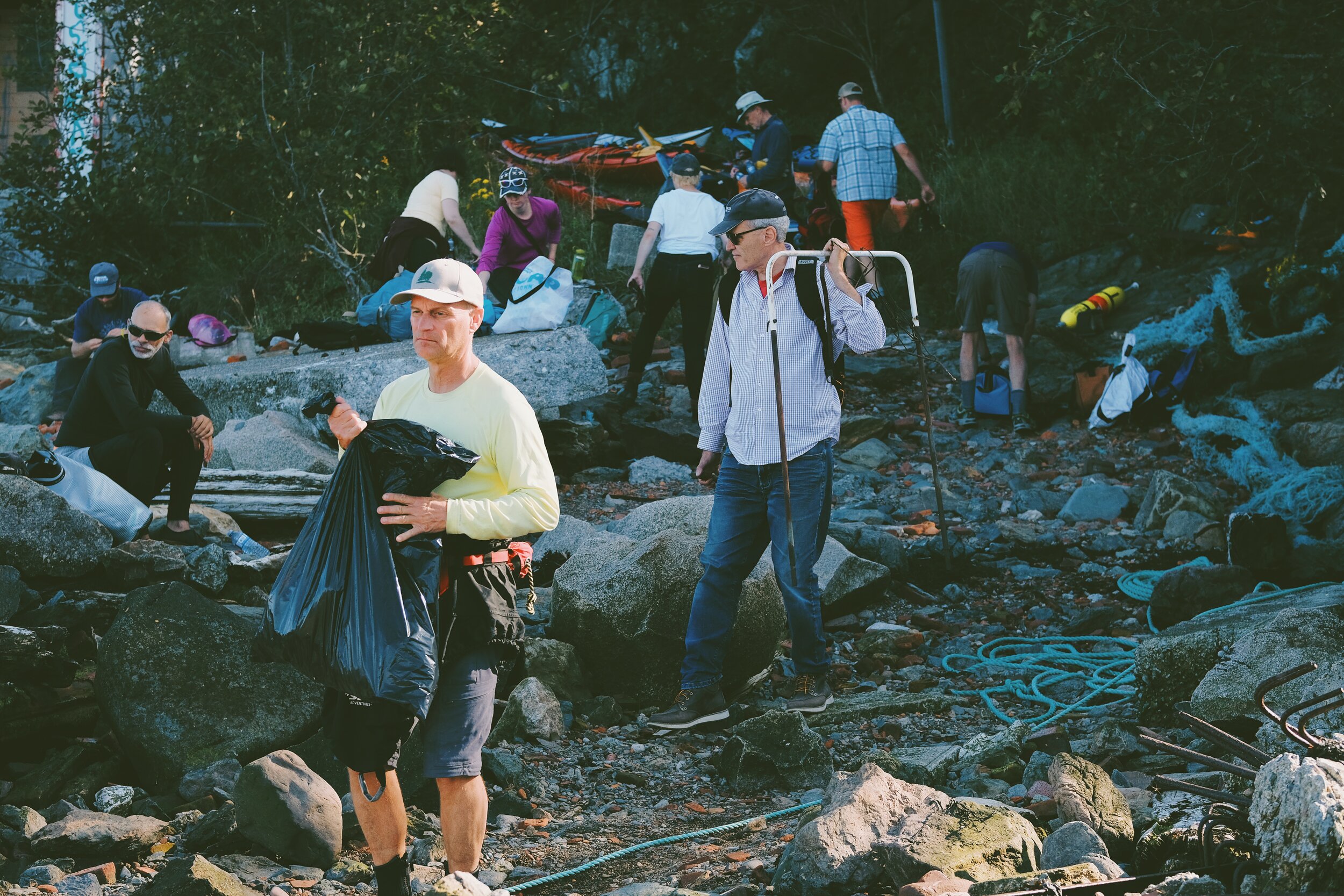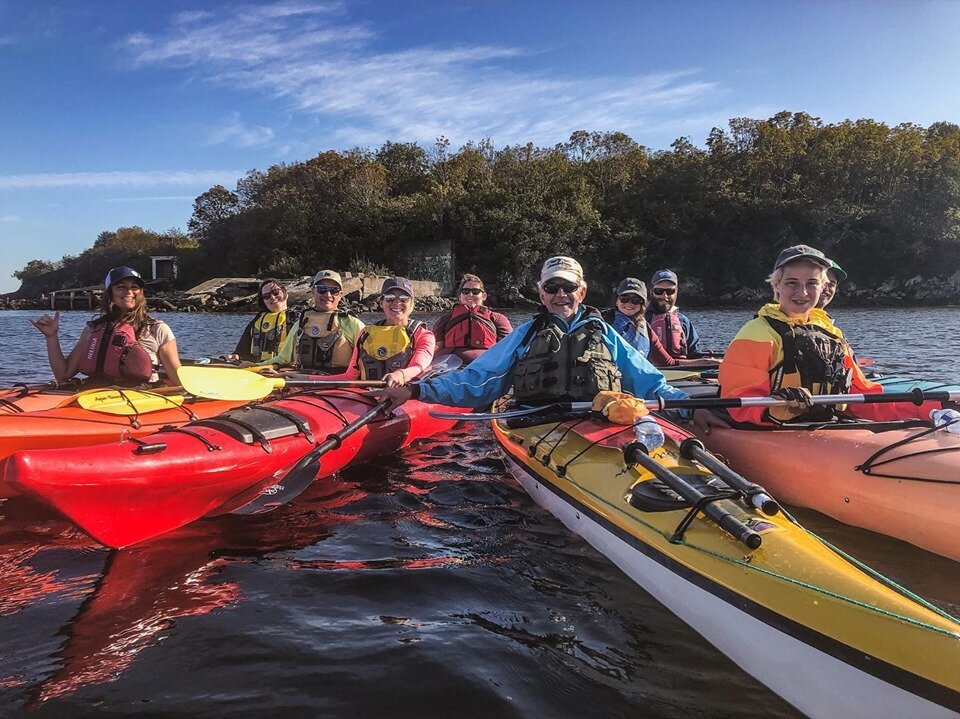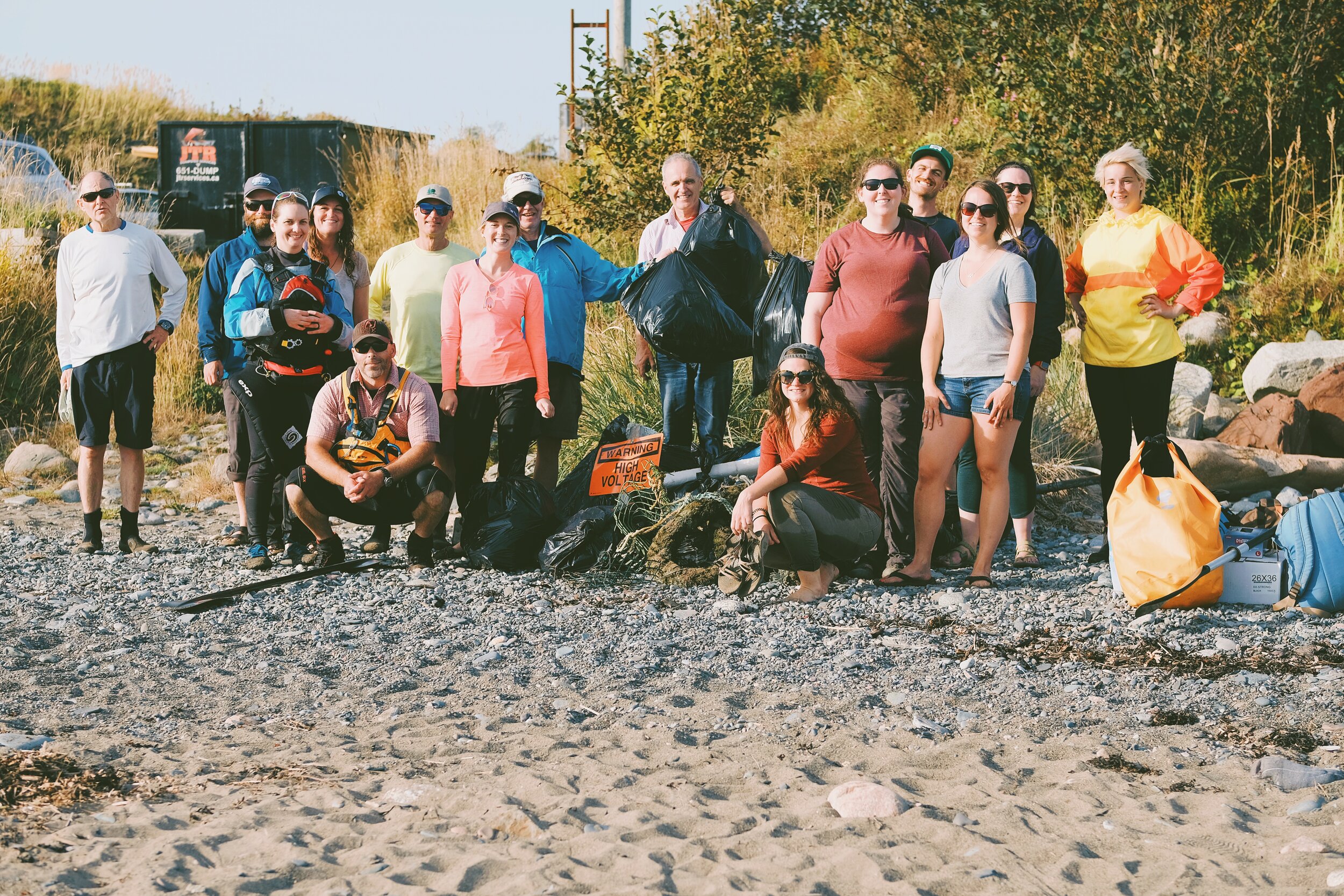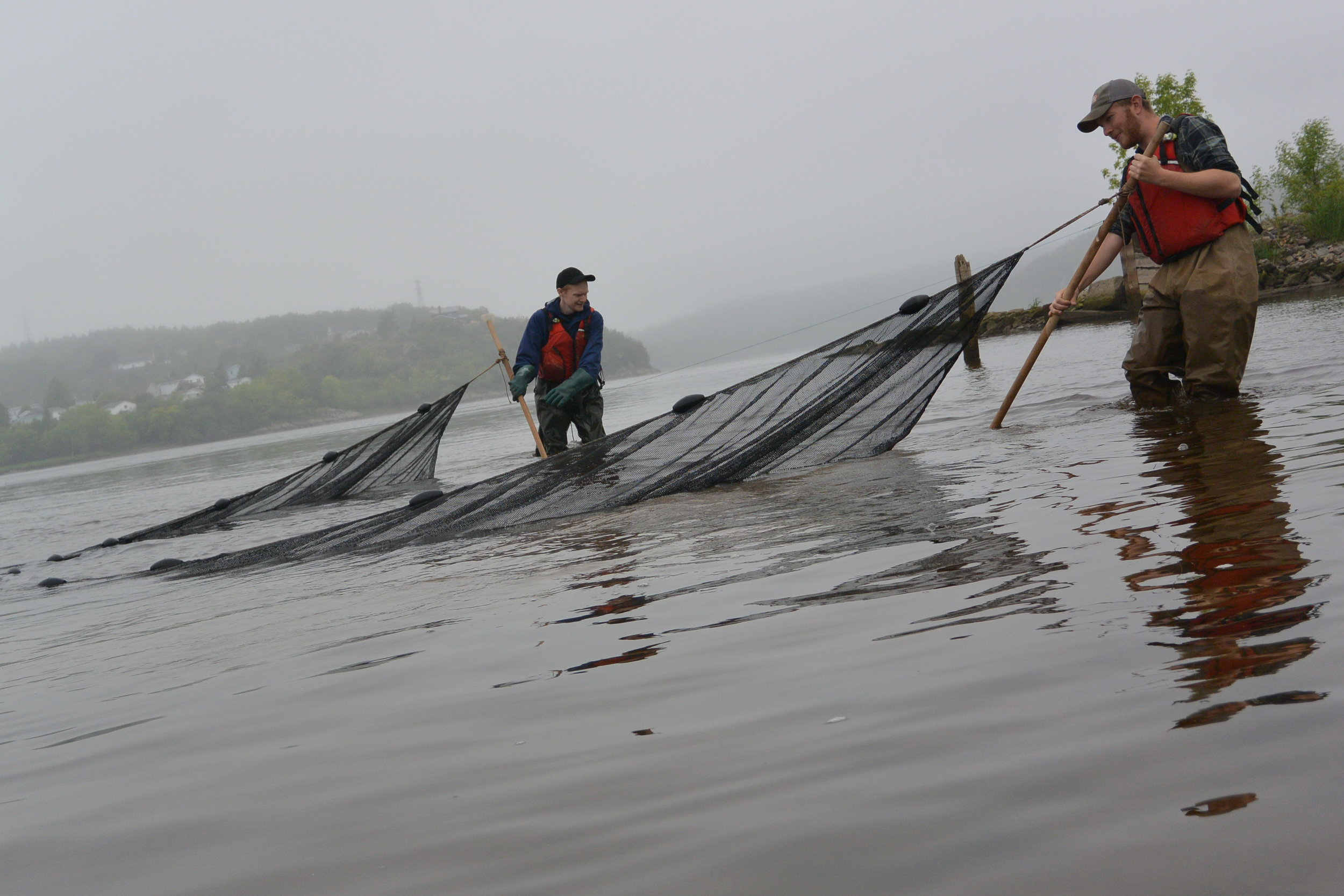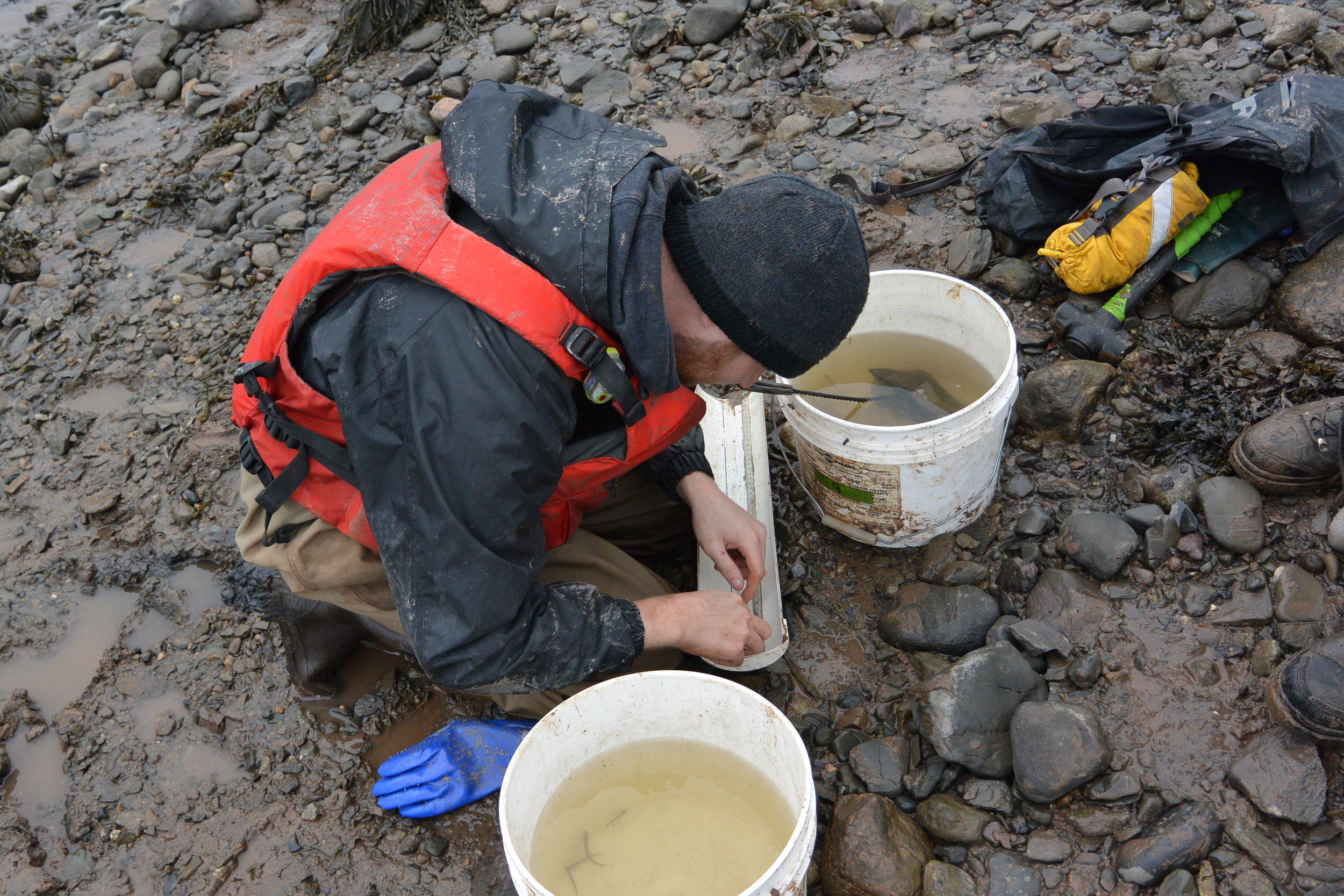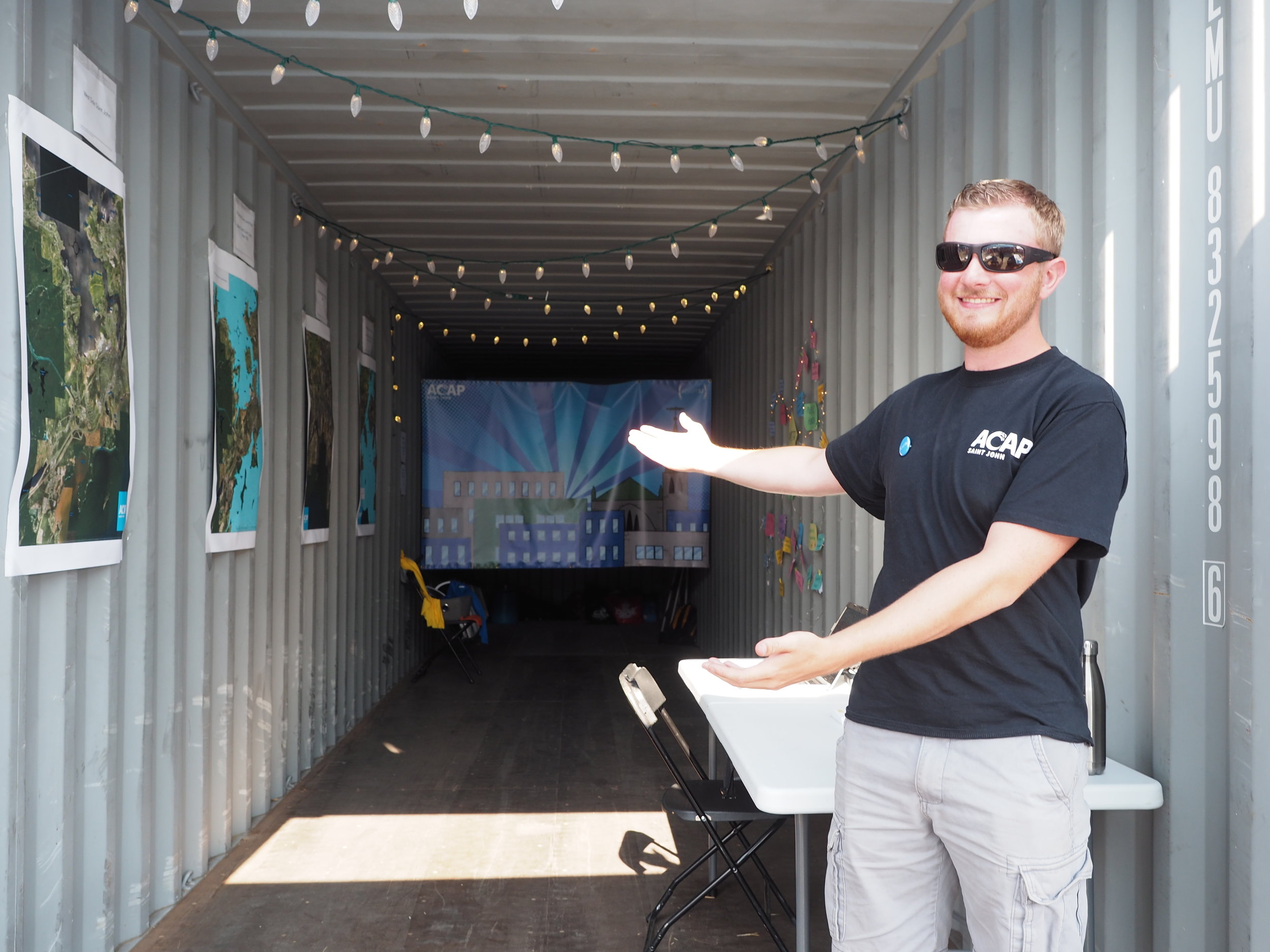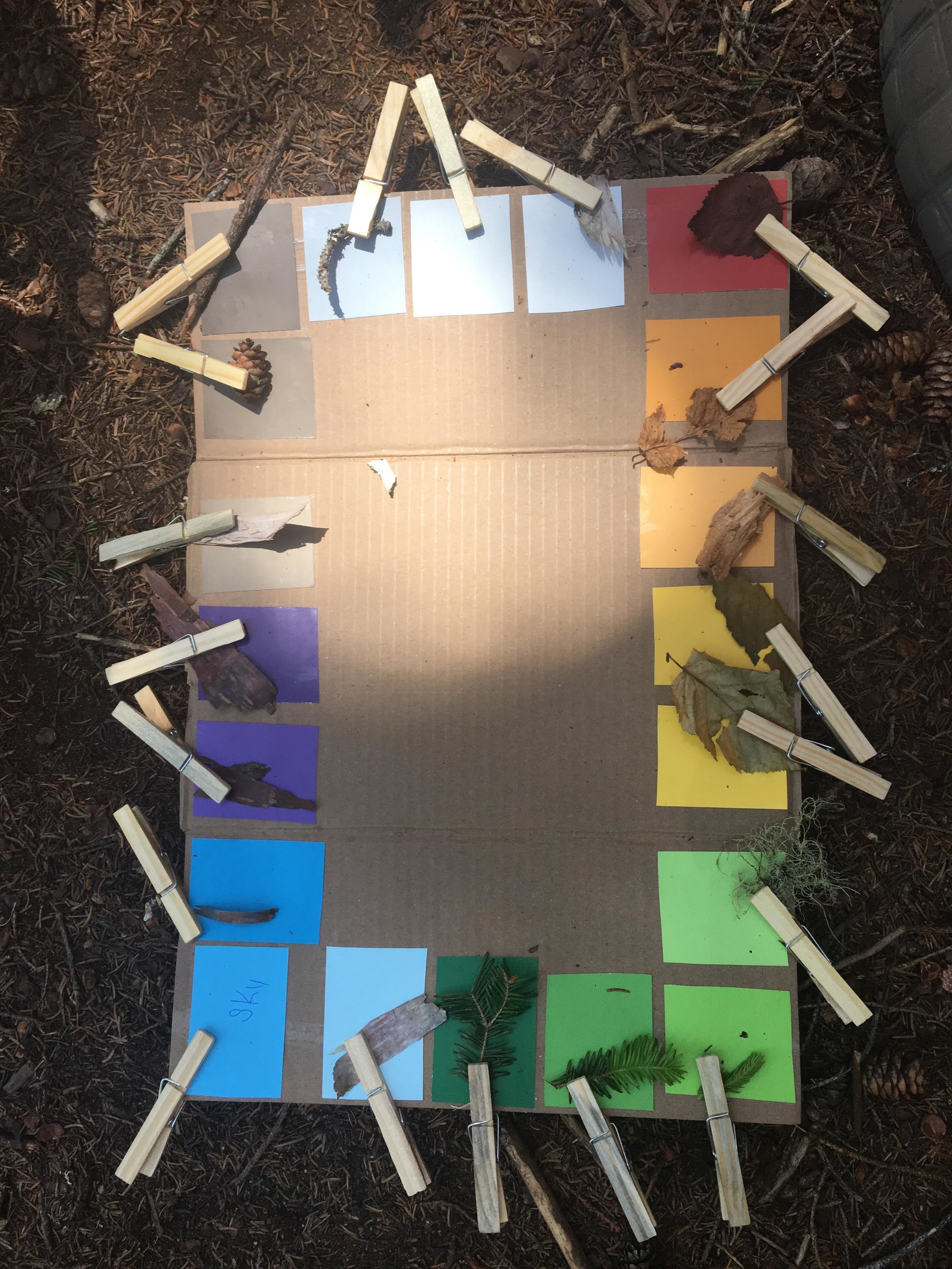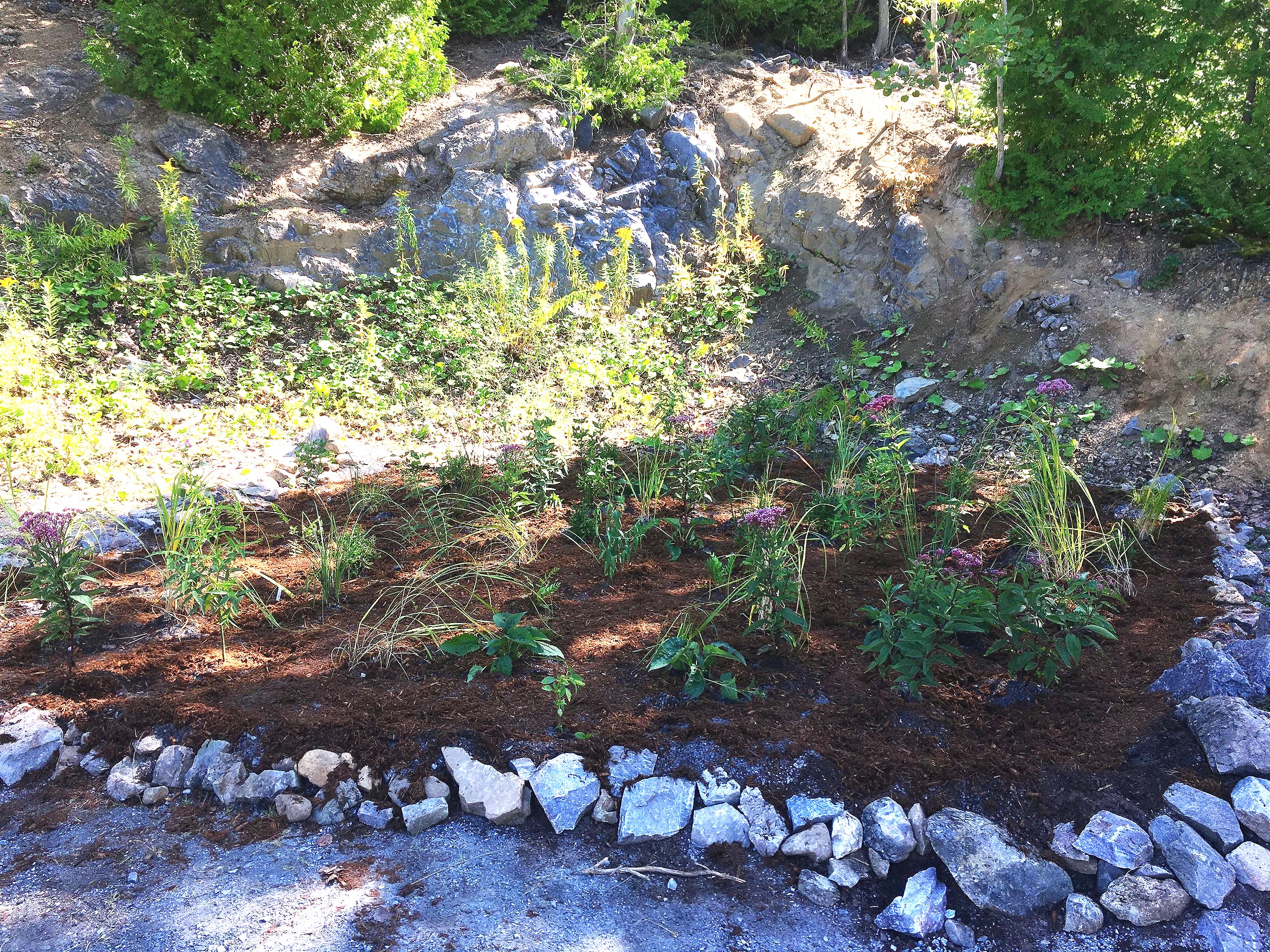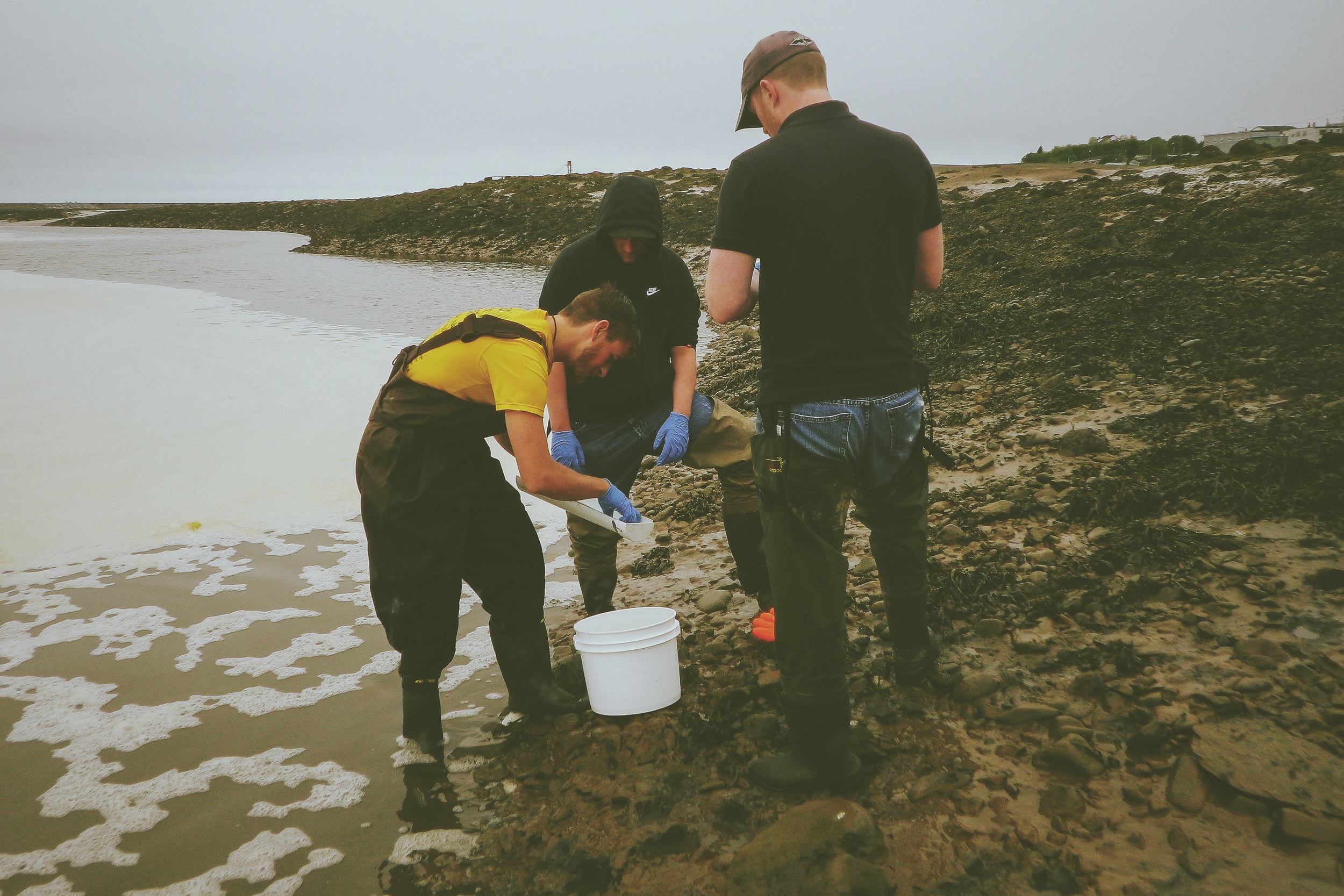
STAFF BLOG
#30yearsACAP Memories - Jean MacDonald
Jean MacDonald has been involved with ACAP Saint John’s board of directors from the very beginning.
Jean (far right) in 2011 when the Environmental Minister visited the ACAP office.
She served as a teacher representative, and on several of the executive positions. She has seen and been a part of many of our projects over the years including Harbour Cleanup, the Paint Swap and many beach sweeps.
Example of erosion issues in Red Head.
A memory that stood out for Jean is the erosion issues at Red Head Beach and the efforts put into place to help slow down erosion in the neighbourhood. Due to the damaging slides, homes in the area were at risk of falling directly into the Bay of Fundy.
Comic, Times Globe (2000)
In 1998, the Red Head Shore Restoration Committee was formed, and through funding from the provincial government and the Regional Development Corporation 4,000 tires were placed at the base of the slope and anchored into the sand using 3/8” rebar. The structure was designed to act as a breakwater to protect the clay slope from further erosion. It was intended that the waves would essentially help the structure by washing sand and silt into the voids between the tires and rocks.
By 1999, various winter storms had weakened the structure considerably, rebar had loosened, and some tires had floated free from their anchors - the structure was a complete failure. Not only did this result in scattering tires over a large portion of the beach, but it also created a human health and safety risk associated with hundreds of pieces of rebar and steel-reinforced tire remnant jutting from the sand and water.
Tire removal at Red Head beach (2000)
Subsequent cleanup efforts by ACAP Saint John and various partners removed over half the tires and over ten tonnes of steel (tire rims and rebar) between 2000 and 2001. It was actually Jean’s Environmental Science class from the Woodlawn Learning Centre that came out and were was able see environmental problems first hand in their community. Jean’s students were eager to aid in the cleanup and met Tim Vickers at the beach and went to work. The class got to work immediately digging tires and rebar out of the sand. They were successful retrieving a great amount of tires and were eager to keep going!
Newspaper article (2000)
Thanks to the hard work of Jean’s class and community volunteers many tires have been removed from the beach, however erosion challenges are still prevalent in the Red Head community. In 2021 ACAP visited the area to assess the condition of the shoreline as part of a larger project that looked at 10 coastal areas in Saint John. During the assessment many tires and rebar were observed along the beach demonstrating the long-term impacts that can be associated with protective installations. While there is no single solution for erosion, education is critical for building awareness whether it is through reading our Living Coastal report or through beach cleanups where volunteers physically observe the impacts of erosion. The work that Jean and her students completed during the Red Head tire removal project not only resulted in an improvement in the environmental conditions on the beach, but also provided valuable information about future cleanup initiatives.
#30yearsACAP Memories - Sean Brillant
Sean Brillant began his ACAP journey in 1993 as the project coordinator for the Community Environmental Quality Assessment, a precursor for the Community Environmental Management Plan.
Sean in 2001 showing off some contaminated mussels from Tin Can Beach.
In 1994, Sean started his MSc. at UNBSJ supported by ACAP studying the contaminant loading and distribution in the tissues of intertidal animals across the SJ Harbour and in 1997, he began his role as Executive Director until 2003. During this time, he worked on several renowned ACAP projects and engaged with many members of the community and the board of directors.
Household Hazardous Waste Reduction Project
When we asked Sean to chat about one of his most memorable projects he worked on during his time with ACAP, he immediately mentioned the Household Hazardous Waste Project, which ran from 1994-1995. This project reached over 25 schools and was presented to approximately 3,000 children!
Take a look at what Sean had to say!
The ACAPSJ Household Hazardous Waste Program is a project that I still use as an example of effective education-based action project. The goal of this program was to reduce the amount of (environmentally) hazardous materials from entering our mostly untreated sewerage system, as well as our local waterways.
September 94’ ACAP News Letter
This was done by providing presentations to school classrooms, grades 4 to 6, about the types of environmentally hazardous materials that may be in their homes. Students were provided with a checklist of these materials, a sheet of big bright blue stickers, and a list of simple but effective non-hazardous alternatives for each of the materials. As a follow-up activity for their home, students were asked to work with a parent or adult to go throughout their homes together to find these hazardous materials and to mark them with the bright blue stickers.
Example of the stickers that were given out to students to place on hazardous products in their homes. We found this really old sticker on a large bottle of iodine in our storage room!
The result was that not only that the students became aware of what materials in their homes may be hazardous, but so did the parent and the big stickers made sure this awareness was reinforced whenever the material was used.
Additionally, the non-hazardous alternatives for these materials allowed homeowners to know how to replace these materials. Although a large proportion of checklists were returned to ACAP Saint John, indicating the program was widely used, the extent of hazardous materials that were diverted could not be measured. Nonetheless, this multi-pronged approach to education and personal action for reducing the effect of human activities on the natural world.
Sean now works for the Canadian Wildlife Federation as the senior conservation biologist for Marine Programs.
Education Outreach Program Coordinator (FILLED)
Position Summary
Under the supervision of the Executive Director, the Student Environmental Engagement and Outreach Coordinator will provide support on a number of engagement and outreach activities within our ongoing projects throughout the summer. The Coordinator will lead the development and implementation of programming and resources for classrooms and online education including presentations, lesson plans, interactive games and activities and others. The Coordinator will also provide hands-on support to other project staff. The ideal candidate would be flexible in their working schedule, be able to work within a team, have excellent communication skills and be highly organized.
Responsibilities
Create online and in-class resources to engage youth in environmental learning;
Deliver presentations to youth and special interest groups throughout the community, either virtually or in person;
Update existing educational materials and develop new resources as required;
Assist with promotion of all educational resources;
Participate in outreach events throughout the Greater Saint John Area;
Plan, implement and monitor content for ACAP Saint John’s various Social Media platforms;
Maintain a detailed database of outreach activities, including numbers of people reached;
Perform a variety of administrative support duties.
Qualifications/Skills
Ability to effectively communicate with strong writing, presentation and listening skills.
Ability to coordinate design marketing materials and presentations.
Ability to use social media platforms to increase public awareness for environmental programs.
Excellent organization skills to balance a number of tasks and complete work in a timely manner.
Demonstrated ability to plan, organize and direct new programs.
Advanced knowledge of Microsoft Office programs and internet applications.
Ability to work independently with good self-motivation.
Additional Information
The advertised position is designed to be seasonal full-time [40 hours per week] for 8 weeks funded by Canada Summer Jobs.
To be eligible, youth must:
Be between 15 and 30 years of age at the start of the employment;
Be a Canadian citizen, permanent resident, or person to whom refugee protection has been conferred under the Immigration and Refugee Protection Act for the duration of the employment;
Have a valid Social Insurance Number at the start of employment and be legally entitled to work in Canada in accordance with relevant provincial or territorial legislation and regulations.
ACAP Saint John is an equal opportunity employer. We welcome diversity in the workplace and encourage applications from all qualified candidates including women, members of visible minorities, persons of all physical abilities, and Indigenous peoples.
About ACAP Saint John
For over twenty-five years, ACAP has conducted successful in-school environmental education programs, summer camps, ecological inventories, water quality monitoring programs, habitat restorations, watercourse restorations, wetland enhancements, contaminated site remediation, green space planning, and engaged thousands of area residents in community cleanup initiatives.
ACAP Saint John has an excellent reputation in the community for acting as a third-party mediator of contentious environmental issues, and continues to expand their role as a public source of knowledge and information dissemination. We continue to affect long-term planning for greening and revitalization in Saint John by offering our expertise and our research outcomes to levels of government, corporations and institutions throughout the region.
How to Apply
Please submit your cover letter and resume by May 13, 2022 to executivedirector at acapsj.org * with the subject line, "Environmental Education and Outreach Coordinator" - only those short-listed for an interview will be contacted.
*Note: The e-mail address above has been masked to help prevent spam. Please copy the address and replace “at” with @.
#30yearsACAP Memories - Patrick Desmond
Patrick Desmond became involved with ACAP around 1993. At the time, ACAP was a fledgling organization and one of their first projects was a Materials Exchange (a database where companies list surplus or unused excess materials). Patrick was hired as the coordinator for this project to match the supply of these materials to a final home or user for the materials.
At the time, he was completing his M.Sc. in Environmental Studies at UNB Fredericton. During his first year of being hired, the Executive Director, Frank Hogan, left to pursue other interests. The Board suggested that Patrick would make a good replacement for Frank. However, being a full time student plus having a full time job was thought to be too much, so Patrick had a great idea: share the Executive Director’s job! Allison Lowe was in Patrick’s grad school class and decided to both work part time hours as ED and still have time to finish their degrees. Allison and Patrick shared the ED position for almost 5 years!
Paint Swap
Check out what Patrick had to say about one of his most memorable ACAP projects!
Advertisement for the Paint Swap event
The project which I most enjoyed was the Paint Swap. We ran it for 2 -3 years. The idea – piggy backing on the Materials Exchange idea - was to keep left over paint out of the landfill by having a one day event where people brought in leftover/excess paint and then the volunteers would mix latex paints together and oil paints together and give it out free of charge to anyone that wanted it. We advertised it heavily and received permission from McAllister Mall to set up in one corner of the parking lot to run the exchange.
1994 Paint Swap event
The first year was a great hit – paint would come in – we opened it up to make sure it was still good – mixed it with other like paints and then handed it back out. Any paint that was no good we had hired Laidlaw Environmental to take it away in totes which they supplied. Empty cans were put in a dumpster. The lineup to receive good paint was unbelievable. People would line up and stand there and just take whatever we would give out. Any good paint was almost gone immediately.
1997 Paint Swap event
With the great success of the first year, we planned a second one the following year. The funding to pay Laidlaw came from the Environmental Trust Fund and the bill was over $10,000 the first year. Well, the second year Paint Swap made the first one appear like a dud. The day of the event, the cars were lined up 25 – 50 deep to drop off paint! People were pushing hard to get the good paint. It was full on pandemonium at times. Some cars drove up and dropped off full, unopened cans of paint. It was then that other issues began to emerge – one guy showed up with what looked like dynamite sticks he wanted to get rid of – other people were dropping off pesticides and other materials that we really didn’t want or expect. It was a good thing the Laidlaw guys were there to handle all of these unexpected items.
While it was a huge success, the bill from Laidlaws doubled or tripled from Year 1 to Year 2. Concerns were raised at the Board level of liability of volunteers being injured with some of the material coming in. It is here that my memory gets foggy as I don’t think we ran it the third year. I think we submitted the proposal for a third year but the Environmental Trust Fund did not want to give us the money as the cost of the project was starting to be much more than they wanted to spend for paint disposal. That and the liability of the volunteers weighed heavily on the Board members concerns.
We found this report from 1997 indicting the Paint Swap ran for 4 years!
I look back at this project as one of the best for a number of reasons: HUGE community buy in, many volunteers worked and loved the project, huge amounts of paint, oil and latex kept out of the landfill and proper disposal of waste paint. I just loved this project.
With the price of paint now – maybe it is time to start another Paint Swap!!
Employment Opportunity - Office Manager (Filled)
EMPLOYMENT OPPORTUNITY
Office Manager
ACAP Saint John is growing, and we are looking for an Office Manager to join our dynamic team! We are looking for a driven, positive person that thrives in a rapid, ever-changing environment. We seek people who are passionate about the environment and fostering environmental improvements within the region. If you are a hard-working and reliable team member with previous office and/or administration experience we would love to hear from you.
Job Description
The Office Manager will ensure that ACAP Saint John’s administrative requirements are completed, updated, and continually improved upon to increase efficiency. Along with administrative duties, the Office Manager will aid in correspondence with stakeholders, funders, volunteers, government and other community groups.
Tasks/Responsibilities
Bank reconciliations
Aid in organization’s annual financial audit
Maintain all necessary reporting to federal and provincial governments
Maintaining credit card receipts, deposit records, and reconciliation
Manage and update accounts payable and receivable
Correspondence and reporting to accountant and CRA, according to generally accepted accounting principles and the predetermined needs of the Board of Directors
Maintain organization’s filing system and record keeping.
Collect, coordinate, and organize ingoing and outgoing mail
Perform general office duties including filing, faxing, answering the telephone, checking voicemail and taking messages, document production, addressing general public inquiries made via telephone, in person, or social media, and helping to keep the office premises tidy
Documenting project finances and submitting financial claims to funders
Assist with office and equipment upkeep
Assist with the documentation of policies and procedures
Assist with social media engagement tracking and inquires
Assist with project activities and organizational promotion as needed
Additional Information
The advertised position is designed to be full-time, from November 1, 2021 [or whenever a successful applicant is selected] for an initial period to March 31, 2022 with a possibility of extension.
ACAP Saint John is an equal opportunity employer. We welcome diversity in the workplace and encourage applications from all qualified candidates including women, members of visible minorities, persons of all physical abilities, and Indigenous peoples.
About ACAP Saint John
For over twenty-five years, ACAP has conducted successful in-school environmental education programs, summer camps, ecological inventories, water quality monitoring programs, habitat restorations, watercourse restorations, wetland enhancements, contaminated site remediation, green space planning, and engaged thousands of area residents in community cleanup initiatives.
ACAP Saint John has an excellent reputation in the community for acting as a third-party mediator of contentious environmental issues, and continues to expand their role as a public source of knowledge and information dissemination. We continue to affect long-term planning for greening and revitalization in Saint John by offering our expertise and our research outcomes to levels of government, corporations and institutions throughout the region.
How to Apply
Please submit your cover letter and resume by October 25, 2021 to executivedirector at acapsj.org * with the subject line, "Office Manager" - only those short-listed for an interview will be contacted.
*Note: The e-mail address above has been masked to help prevent spam. Please copy the address and replace “at” with @.
In the Streams, Living the Dream
I have been admiring ACAP for years now; their work inspired me to pursue the Environmental Technology program at NBCC Miramichi. As a summer student at ACAP, I felt as though I was on an adventure rather than working. At the beginning of my placement, I spent most of my time conducting stream assessments within the main stems of Henderson Brook and Spruce Lake, as well as the entire Mill Creek watershed. Heavy bug and bushwhacking led us to seldom visited areas that were inexplicably beautiful. We found many treasures including multiple waterfalls, fascinating bedrock, a cave, a swing beside a beaver dam, and two Barred owls in the same tree!
The purpose of the assessments was to locate any blockages that may interfere with fish migration. We were able to breech one of the largest blockages that we came across; it was some of the hardest labour I have ever done but nothing was more enjoyable or satisfying than removing the jam and watching the water flow.
I was also able to assist with numerous shoreline assessments as part of a project that aims to monitor coastal erosion of vulnerable areas in Saint John. Through measuring and observing erosion, vegetation, soil type, as well as foreshore and backshore type, we were able to determine the stability of the area’s shoreline. This will allow ACAP to build awareness of this very real problem so that we can be more prepared as a community as we plan for prevention and adaptation. We learned a lot during our assessments of the shorelines in areas such as Red Head, Anthony’s Cove, and Bayshore Beach; some of the most valuable information was shared with us by residents experiencing erosion firsthand.
Maggie Brogan, Field Technician, determining slope of erosion at Bayshore Beach.
It was a privilege to be part of ACAP and to work with such a knowledgeable team who are so willing to share their experience and expertise. The more I have learned, the more aware I have become of the interconnectedness of everything around me. They say that if you do what you love, you will never work a day in your life; I have very much found this to be true. I am so grateful for this opportunity, and I look forward to seeing the projects and reports come to life, and the exciting work that is in store for the ACAP team.
Shayelin Braydon
My Practicum at ACAP
As an Environmental Technology Student at NBCC we have the opportunity in our second year to do a work practicum. I was lucky to be able to complete my practicum at ACAP Saint John! I wanted to go somewhere I would get a variety of experiences. I definitely chose the right place!
I have followed ACAP Saint John on social media for quite a while now and they always seemed to be doing really awesome things like education and outreach at schools, organizing beach cleanups, making rain gardens, seal monitoring, fishing in the harbour and much more! I was happy to be able to participate in most of these activities.
I got to help with the weeding of the rain gardens, set up rain barrels, and put signs up at multiple locations around Saint John. I tagged along while looking for tree planting sites, helped out for fishing week, went seal monitoring, and went to schools to engage with the students through outdoor activities.
My favorite week was fishing week! I got to go fishing at four different sites in Saint John. I got to use a couple of different types of nets to catch fish and shrimp. We identified each species, measured them, then released them back into the water. The coolest fish I saw was a huge winter flounder that measured 350 mm long!
I also really enjoyed the education and outreach that ACAP did with schools over the past five weeks. I was able to go to a few different schools, one of which took me to Deer Island. Another project I was happy to take part of was nutrient sampling. We spent a day going to various sites along the Saint John River and its tributaries.
Through all these experiences I got to see parts of Saint John that I have never been before. Being from the Norton area I did not have any experience working along the coast and through this practicum I was able to gain this incredible experience.
Thank you so much to the ACAP team for teaching me so many things. I am very grateful to have this opportunity.
Amelia King
Employment Opportunities - Field Technician (Summer Positions)
Employment opportunity
Field Technician - Summer Student
ACAP Saint John is looking for enthusiastic team players to fill our two Field Technician roles. This role is a 4-month full-time position beginning in late April or early May 2021 and ending in August 2021 (final dates to be negotiated). The Field Technician will help with ongoing projects including (but not limited to) in-field collection of various samples, calibration of laboratory equipment including portable field meters, internet research, summary report writing, analysis and interpretation of the collected raw data and presentation of the final results. The successful candidate will also assist in organizing community events, including education programs, St. John River Summit, green space beautification and tree planting, as well as coordinating volunteers to assist in event operations.
Responsibilities
Conduct hands-on field work with a wide variety of projects including the Harbour Baseline project;
Help to deliver public presentations and community outreach;
Manage AWN’s Water Monitoring Equipment Hub program in New Brunswick. This includes the coordination of loans, equipment pickup/drop-off throughout the field season, and performing equipment calibrations prior to loaning;
Plan, implement and monitor content for ACAP Saint John’s various Social Media platforms.
Qualifications/Skills
Post-secondary education with a concentration in environmental science, biology, fisheries/wildlife management;
Self motivated with the ability to work independently;
Ability to perform and multi-task in challenging work environments and weather conditions;
Strong organizational skills, attention to detail, and efficient time management;
Strong oral and written communication skills;
Flexible and adaptable to a changing work schedule (including weekend and evening work).
Additional Information
The advertised position is designed to be full-time [40 hours per week] summer student position starting May 1, 2021 [or whenever a successful applicant is selected] to August 31, 2021.
ACAP Saint John is an equal opportunity employer. We welcome diversity in the workplace and encourage applications from all qualified candidates including women, members of visible minorities, persons of all physical abilities, and Indigenous peoples.
About ACAP Saint John
For over twenty-five years, ACAP has conducted successful in-school environmental education programs, summer camps, ecological inventories, water quality monitoring programs, habitat restorations, watercourse restorations, wetland enhancements, contaminated site remediation, green space planning, and engaged thousands of area residents in community cleanup initiatives.
ACAP Saint John has an excellent reputation in the community for acting as a third-party mediator of contentious environmental issues, and continues to expand their role as a public source of knowledge and information dissemination. We continue to affect long-term planning for greening and revitalization in Saint John by offering our expertise and our research outcomes to levels of government, corporations and institutions throughout the region.
How to Apply
Please submit your cover letter and resume by April 21, 2021 to executivedirector at acapsj.org * with the subject line, "Field Technician" - only those short-listed for an interview will be contacted.
*Note: The e-mail address above has been masked to help prevent spam. Please copy the address and replace “at” with @.
Employment Opportunity - Harbour Monitoring Coordinator (filled)
EMPLOYMENT OPPORTUNITY
HARBOUR MONITORING COORDINATOR
ACAP Saint John is seeking an experienced individual to join our team as the Harbour Monitoring Coordinator. The Coordinator will oversee all aspects the Harbour Baseline project and conduct all required sampling needed (i.e., water quality monitoring at various sites, lab analysis of collected water samples, fish community and sedimentation sampling at multiple locations). The successful candidate must also be willing to assist with other ACAP Saint John projects and outreach opportunities as needed.
Responsibilities
Organize and complete all necessary hands-on field work related to the Harbour Baseline project (i.e., fish communities, sediment samples, water samples);
Conduct data management and data entry;
Help to deliver public and school presentations and community outreach;
Prepare final reports;
Assist in writing grant proposals for future funding opportunities.
Qualifications/Skills
Post-secondary education with a concentration in environmental science, biology, fisheries/wildlife management;
Self motivated with the ability to work independently;
Ability to perform and multi-task in challenging work environments and weather conditions;
Strong organizational skills, attention to detail, and efficient time management;
Strong oral and written communication skills;
Flexible and adaptable to a changing work schedule (including weekend and evening work);
Knowledge of the Saint John Harbour (including fish species) and experience with statistical analysis would be considered an asset.
Additional Information
The advertised position is designed to be full-time [40 hours per week], from May 1, 2021 [or whenever a successful applicant is selected] for an initial period to March 31, 2022 with a possibility of extension.
ACAP Saint John is an equal opportunity employer. We welcome diversity in the workplace and encourage applications from all qualified candidates including women, members of visible minorities, persons of all physical abilities, and Indigenous peoples.
About ACAP Saint John
For over twenty-five years, ACAP has conducted successful in-school environmental education programs, summer camps, ecological inventories, water quality monitoring programs, habitat restorations, watercourse restorations, wetland enhancements, contaminated site remediation, green space planning, and engaged thousands of area residents in community cleanup initiatives.
ACAP Saint John has an excellent reputation in the community for acting as a third-party mediator of contentious environmental issues, and continues to expand their role as a public source of knowledge and information dissemination. We continue to affect long-term planning for greening and revitalization in Saint John by offering our expertise and our research outcomes to levels of government, corporations and institutions throughout the region.
How to Apply
Please submit your cover letter and resume by April 15, 2021 to executivedirector at acapsj.org * with the subject line, "Harbour Monitoring Coordinator" - only those short-listed for an interview will be contacted.
*Note: The e-mail address above has been masked to help prevent spam. Please copy the address and replace “at” with @.
Goodbye paper towels, hello zero-waste alternative!
A DIY tutorial for reusable “Unpaper” towels.
Almost everyone uses paper towels! They’re so handy and absorbent and always right there when you need them. But, have you ever stopped to wonder what environmental impact paper towels have? When you look at the entire lifecycle of a piece of paper towel there are many behind-the-scenes inputs or processes that we wouldn’t normally consider. For example harvesting trees, transporting raw materials or finished products, chemical inputs (from forestry or pulp mill), fresh water usage, water treatment, transport to stores/consumers, and of course the disposal in the landfill. One calculation of the global warming potential for paper towel (the amount of greenhouse gasses that are emitted by the cradle to grave production and consumption of a product interpreted as mass of carbon dioxide) was about 0.06 lbs or 27 grams of carbon dioxide for each towel produced and used. So, the mass of carbon dioxide produced outweighs the paper towel itself (roughly 2 grams per sheet) thirteen times over. If you use 5-10 pieces of paper towel in a day, after one year your paper towels would generate the equivalent of 109-219 lbs of carbon dioxide [1]. The use of paper towels is therefore contributing to climate change through greenhouse gas emissions and leads to unnecessary paper and plastic waste.
Paper towels are made in a similar way to other popular paper products like cardboard, writing paper, and tissues. Each of these products is molded from a pulp that contains a mixture of small pieces of wood and water. Producing these sources of materials requires trees, chemicals, fuel, water, and electricity - contributing to millions of metric tons of emissions annually. While manufacturing causes many issues like pollution and the reduction of natural resources like trees and water, the disposal of these towels is also an issue [2].
Although paper towels are compostable, they often end up in the landfill and will not be made into usable compost. In addition, excessive plastic packaging around a pack of paper towels also contributes to waste production at your local landfill.
Interested in finding an alternative to paper towels?
There are options other than traditional paper towels that will still help you wipe, dry, and clean with fewer negative impacts on the environment! Plus, they will even help save on costs. The average family uses two rolls of paper towel every week. At roughly $3.20 for 2 rolls [3] that equals out to $166 in paper towels yearly.
Some alternatives include cotton napkins, rags, sponges, etc. Switching to a reusable option will save you money in the long run and reduce your paper towel consumption/waste! Since these reusable options are small towels, they can sneak in with your regular laundry, too. One eco-suggestion would be to stick with natural fiber cloths (i.e. cotton based) since frequently machine washing fabrics made of synthetic materials can contribute to microplastic pollution in waterways.
Keep reading below to learn how to DIY our favourite paper towel alternative!
Our DIY ‘Unpaper Towel’ Tutorial
Sewing Machine Required
Unpaper Towels are reusable towels that attach together so you can still have them on a roll on your counter and keep them accessible. But when you are done, you wash and reuse them instead of throwing them away leading to less waste in your trash and you’ll save money buying fewer paper towels! These towels are a homemade, DIY option that are easy to make right at home with the proper equipment!
What you’ll need
Absorbent natural fiber fabric (i.e. flannel, terrycloth, muslin cloth) - 2 meters of flannel is $16, or even better, repurpose old flannel shirts/jammies for free
Sharp scissors
Sewing machine or serger
Thread
Ruler
Iron
Optional if adding snaps to towels:
An empty paper towel roll
Fusible interfacing (local fabric store) - 1 meter is $5
4 plastic snaps per towel (local fabric store) - 1 package is $13
Snap setting tool - $24
Altogether this will make about 30 single-ply towels or 15 two-ply towels. Without the snap option this will cost roughly $16 for fabric or FREE if repurposing old clothing!
Making these towels with the snaps will cost roughly $58 for fabric and snaps/snap setter tool.
These towels will last for years, so no matter what option you choose, you will be saving money and reducing your waste!
As an FYI when deciding between snaps or no snaps, with enough care the flannel towels without snaps can still be rolled up together and displayed like traditional paper towel since the towels stick together. You could also put them in a cute basket or drawer.
Step 1: Get your absorbent fabrics ready
Here we purchased new flannel material, which is an absorbent cotton fabric. In this tutorial we will be creating two-ply towels from this fabric but you can also use something like terry cloth or muslin fabric on one side of the towels to mix things up, or, as mentioned above repurpose flannel shirts/jammies to use!
Step 2: Wash and dry any brand new fabrics
No need for soap! Washing brand new fabric in warm water will pre-shrink them, which is important to do before stitching them together.
Step 3: Iron fabric
Take a few minutes to iron your fabrics before you begin sewing. This will make the stitching process run smoothly.
Step 4: Cut your fabric
Cut your fabric into the size you want your towels to be. Our fabric was cut to 11” x 7” because a paper towel roll is 11” long, but really you can make your towels whatever size you like!
Step 5: Add interfacing to corners (for two-ply snap option)
This step is helpful if you will be adding snaps to your unpaper towels. Add small pieces of fusible interfacing to each corner on the WRONG side of the fabric only where the snaps will connect. You just need to do this to one “ply”. This is a material that will help stabilize the fabric, adding support for holding the snaps securely in place.
Skip this step if you’re just making single-ply towels or if you’re not using snaps.
Step 6: Assemble and start stitching!
If you’re making two-ply towels, as shown in these photos, put the fabrics together with the right sides out so that the interfacing is sandwiched between the two pieces of flannel. You can then stitch all four seams of each sheet.
If making single-ply, go straight to stitching the four sides! These towels were made with a serger using a rolled hem. Any stitch meant for finishing seams would work, such as an overlock or a zig-zag stitch.
Alternatively, to hide the seams you could stitch the pieces of fabric together with the wrong-sides facing out, leaving a 3” gap at the end, then flip the towels right-side out before finishing the stitches. This way seemed more complicated to us and we don’t mind seeing the seams on the exterior.
If you are making single-ply towels without snaps you’re already done!! Lay them all out flat, overlapping each towel onto the previous piece, then roll them onto a repurposed paper towel roll. Or just stack those babies in a cute wicker basket and get ready to wipe up messes while reducing both your consumption and waste!
Step 7: Installing the snaps (only for snap option)
Mark the corners of each towel where the snaps will connect. These snaps were placed roughly 9” apart near each corner. We used plastic snaps so that they won’t scratch any surfaces while cleaning. The applicator used here is a Dritz Plastic Snap Plier Kit from our local fabric store.
When installing these snaps we made sure the two sockets or female components of were consistently pointing down through each towel on one long edge, while the two studs or male components were installed pointing up through the fabric on the opposite long edge. This way the towels always connect to the previous piece in the same way.
Step 8: Add snaps to an empty paper towel roll (only for snap option)
Here we installed two studs or male snap components pointing up through an empty paper towel roll 9” apart where the snap socket on the first towel will connect. This way when the towels connect to the roll the decorative side will be facing outward.
Step 9: Roll it up!
Looky here wiper-snappers, you’re almost done! Snap everything together and roll them up to finish your project.
Voila! These towels will last you for years, reduce your consumption, waste, and save you some dollars in the process. They also make great gifts for that zero-waste fan in your life.
Saint John Sea(l) Dogs
Did You Know?
Did you know that ACAP Saint John has been working on a project observing Harbour seal populations in the Saint John Harbour? This 3-year project (funded by DFO’s Coastal Environmental Baseline Program) involves counting seals as they haul out on rocks at low tide on a biweekly basis. Over time, we are hoping to collect enough data to determine the population numbers of seals in our region and compare it to similar studies that were conducted in the 1990s.
We have six sites that we visit: five sites that are located in the Saint John Harbour and one site located along the Wolastoq [St. John River] (Sea Dog Cove, Summerville). Our observations are conducted every two weeks when the low tide is in the afternoon. Using spotting scopes, binoculars, and (occasionally) drones, we count and record the number of seals that are seen hauled out on the rocks and swimming nearby. Since seals do not migrate south for the winter, we are able to continue with observations throughout the winter (with the exception of the river site since it does freeze).
Map of harbour seal haul out site locations throughout the Saint John Harbour.
Results (so far)
Overall, we’ve been very successful with our sightings. As expected, most sites have more seals in the spring compared to other seasons, likely due to April-June being their mating/pupping season. It was also observed that during the winter months there is a number of seals that haul out at Dog Rocks (along the Irving Nature Park). Since seals don’t necessarily long-distance migrate during the winter, perhaps they move between the different haul out sites throughout the seasons.
Number of seals observed at all haul out sites (excluding Round Reef) from Dec ‘18 - Nov ‘20.
We are very fortunate to have a landowner near the Sea Dog Cove site that completes our freshwater observations for us. She noticed that the seals don’t haul out during the day based on the tides, but based on the time of day. She is more likely to see seals during sunrise and sunset.
Historically there have been sightings of seals on Round Reef (just off Tin Can Beach) and that’s why it was added as an observation site. However, no seals have been observed at this site as of yet! Perhaps they’ve found a better place to sunbathe.
What’s New?
This past summer we teamed up with Gina Lonati, a PhD student from UNBSJ, who is currently studying the health of North Atlantic Right Whale using drones. Gina is helping us by flying her drone over the haul out sites to achieve a more accurate count of the seals. Her fancy drone can also take thermal images of the seals - check it out!
(left): image of seals hauled out at low tide; (right): thermal image of seals hauled out oat low tide. Yellow = hot, blue = cold
What’s Next?
ACAP will continue to collect data for another year. Although it is still too early to make any conclusive results, collecting this data will contribute to filling up data gaps in our region.
CITIZEN SCIENCE
Have you seen any harbour seals lately? We’re interested in hearing from you! If you see any seals at all during your travels, whether they are swimming along the river or hauled out on some rocks, let us know! You can fill out a Seal Sighting Submission Form and let us know how many seals you saw and roughly where you spotted them. This data collected will help us determine the population of seals here in the Saint John Harbour.
Ghost Fishing- As Haunting as It Sounds
As Halloween approaches, I would like to take this time to discuss another “scary” issue that impacts the environment and marine organisms that inhabit the area known as ghost fishing. Ghost fishing is referred to as abandoned, lost, or discarded fishing gear (ALDFG) that continuously entraps a variety of species [3]. When an organism is captured or entangled by ghost gear its chances of survival are low unless it somehow frees itself or is aided by a bystander. These captured species can deplete commercial fish stocks as well as endanger already depleted populations of endangered, threatened, and protected species. Ghost fishing has a widened effect on the environment as it also affects non-mobile parts of the ecosystem including damaging coral reefs and other benthic habitats [3]. Ghost fishing contributes to marine pollution and may also pose a navigational hazard in coastal and even freshwater areas [2].
Figure 1. The ghost fishing cycle (Olive Ridley Project, 2016).
Yes, you may think, fishing has gone on for decades and why is it necessary to do something about it now? When fishing first began, the gear was made from biodegradable material that degraded over time but, with technology advancements and the need for stronger materials, fishing gear is now made up of strong plastics. These plastics (i.e. polypropylene, nylon, polyethylene) do not biodegrade and if left alone will accumulate until removed [5]. It is estimated that ghost fishing gear accounts for over 10% of marine litter by volume with upwards of 640,000 tons of gear lost globally each year [5]. However, due to unstandardized assessment methods, globally this could be a gross underestimate [5]. The 10% may seem like an unsubstantial percentage but, due to ghost fishing working as a cycle, yearly inputs of ghost gear can accumulate and become insurmountable. Ironically, ghost fishing is caused by humans and only human intervention (removal of discarded gear) can break the cycle (Fig. 1).
A porbeagle shark entangled in a bait bag (blue rope around the pectoral fins) in the Bay of Fundy. Credit: Danielle Deonarine, 2020.
A large reason why ghost fishing gear is not retrieved is due to it being illegal to remove another fishermans gear. Gear set out usually has various identification tags marking the gear as a particular fishermans with buoys attached marking where the gear is. If a storm occurs and moves the gear to a different location of where it was set, and remains intact, it is difficult to determine if it is ghost gear or intended to be there. The ghost gear may also be moved to alternate locations due to an excessive amount of gear being used, snags, and interactions with other gear or vessels [3].
Ghost fishing is a global issue that requires a global effort to mitigate the effects on the environment. Research about ghost fishing began in the 1970s but knowledge and awareness about ghost fishing has increased [3]. The increase in knowledge and awareness has allowed the development of organizations focused solely on the removal of ghost fishing gear. Organizations like the Global Ghost Gear Initiative utilize a combined effort with multiple stakeholders from the fishing industry, private sectors, corporates, non-government organizations (NGOs), academia and various governments to develop projects combatting ghost fishing gear [1].
Ghost fishing is a global issue that can be associated with other types of pollution (soil contamination, noise pollution etc.) and influence others (microplastics). It may not necessarily be observed all the time unless you frequent an aquatic environment, but it is still a large issue affecting freshwater and marine species. There are various organizations globally that are attempting to remove ghost fishing gear from the environment with the help of various stakeholders. You may be asking yourself, what you can do to help? Here are some examples:
If you are out fishing, remember to leave the area as it was (or cleaner) when you arrived. Take out all your fishing line, ropes, and hooks. If you see fishing debris left by others, remove that as well.
If you are out exploring the water in a boat, canoe, or kayak and see large amounts of clearly discarded ropes, nets, or debris, attempt to safely remove it. If it is unsafe to do so, you can contact your local Department of Fisheries and Oceans office (marine), Department of Natural Resources (freshwater), or the Huntsman Marine Science Centre (if in the Fundy Region) in order to notify them and they can advise on the next steps to remove the debris safely.
If you go for a walk on the beach and see discarded fishing gear, remove it from the beach and bring it up to a central location by the parking lot. The Huntsman Marine Science Centre also has discarded rope collection bins on various wharves with the #debrisfreefundy initiative.
Participating in the Great Fundy Coastal Cleanup (August), International Coastal Cleanup Day (September 21) or other various cleanups that ACAP Saint John hosts such as the Port City Pickup (October 2020), the Marsh Creek Cleanup (yearly), Partridge Island Cleanup (September 2019), can also make an impact.
If you want to organize your own cleanup, contact ACAP Saint John and we can provide garbage bags and gloves for you to use. We will also coordinate with the City of Saint John to pick up and properly dispose of the garbage you find.
**If you see anything that looks like it could be part of licensed fishing activities (in the water, tagged with identification, and buoys), DO NOT remove it as it could be a fishermans set gear for a particular fishery and removing that is illegal.**
References
1. Global Ghost Gear Initiative. 2020. A global effort. Retrieved online: https://www.ghostgear.org/
2. Macfadyen, G., Huntington, T., Cappell, R. 2009. Abandoned, Lost or Otherwise Discarded Fishing Gear (No. 523). Food and Agriculture Organization of the United Nations (FAO).
3. NOAA Marine Debris Program. 2015. Report on the impacts of “ghost fishing” via derelict fishing gear. Silver Spring, MD. 25 pp.
4. Olive Ridley Project. 2017. Resources and publications. Retrieved online : https://oliveridleyproject.org/orp-mission/resources-and-publications
5. Stelfox, M., Hudgins, J., Sweet, M. 2016. A review of ghost gear entanglement amongst marine mammals, reptiles and elasmobranchs. Marine Pollution Bulletin 111, 6-17.
Employment Opportunity - Environmental Education and Outreach Coordinator (Filled)
Position Summary
Under the supervision of the Executive Director, the Environmental Engagement and Outreach Coordinator will provide support on a number of engagement and outreach activities within our ongoing projects. The Coordinator will lead the development and implementation of programming and resources for classrooms and online education including presentations, lesson plans, interactive games and activities and others. The Coordinator will also provide hands-on support to other project staff. The ideal candidate would be flexible in their working schedule, be able to work within a team, have excellent communication skills and be highly organized.
Responsibilities
Create online and in-class resources to engage youth in environmental learning;
Initiate contact with schools and special interest groups to promote current environmental initiatives;
Deliver presentations to students and special interest groups throughout the community, either virtually or in person;
Update existing educational materials and develop new resources as required;
Assist with promotion of all educational resources;
Participate in outreach events throughout the Greater Saint John Area;
Plan, implement and monitoring content for ACAP Saint John’s various Social Media platforms;
Maintain a detailed database of outreach activities, including numbers of people reached;
Perform a variety of administrative support duties.
Qualifications/Skills
Ability to effectively communicate with strong writing, presentation and listening skills.
Ability to coordinate design marketing materials and presentations.
Ability to use social media platforms to increase public awareness for environmental programs.
Excellent organization skills to balance a number of tasks and complete work in a timely manner.
Demonstrated ability to plan, organize and direct new programs.
Advanced knowledge of Microsoft Office programs and internet applications.
Ability to work independently with good self-motivation.
Application Requirements
This position is funded through a grant from the Clean Foundation (in partnership with Environment and Climate Change Canada) that has the following requirements of the applicant:
Graduated from a post-secondary program
No more than 30 years of age at the start of the internship
Canadian citizen, permanent resident, or person granted refugee status in Canada
Not receiving employment insurance during internship
Confirm your eligibility here
Additional Information
The advertised position is designed to be full-time [40 hours per week], from October 1, 2020 [or whenever a successful applicant is selected] for an initial period to March 31, 2021 with a possibility of extension.
ACAP Saint John is an equal opportunity employer. We welcome diversity in the workplace and encourage applications from all qualified candidates including women, members of visible minorities, persons of all physical abilities, and Indigenous peoples.
About ACAP Saint John
For over twenty-five years, ACAP has conducted successful in-school environmental education programs, summer camps, ecological inventories, water quality monitoring programs, habitat restorations, watercourse restorations, wetland enhancements, contaminated site remediation, green space planning, and engaged thousands of area residents in community cleanup initiatives.
ACAP Saint John has an excellent reputation in the community for acting as a third-party mediator of contentious environmental issues, and continues to expand their role as a public source of knowledge and information dissemination. We continue to affect long-term planning for greening and revitalization in Saint John by offering our expertise and our research outcomes to levels of government, corporations and institutions throughout the region.
How to Apply
Please submit your cover letter and resume by September 14, 2020 to executivedirector at acapsj.org * with the subject line, "Environmental Education and Outreach Coordinator" - only those short-listed for an interview will be contacted.
*Note: The e-mail address above has been masked to help prevent spam. Please copy the address and replace “at” with @.
A New Era
If 2020 has taught us anything, it is that even the best laid plans go often awry and we must all be prepared for the unexpected. Having people who can look beyond the challenge and see the opportunity inherent in it has become essential to not only surviving uncertainty but thriving as a result of it.
For over twelve years ACAP Saint John has been a second home, the people working and volunteering around me have been a second family, and the experiences the organization has brought my way will undoubtedly stay with me for the rest of my life. From volunteering many years ago, to coming back to work as Project Manager, to taking over as Executive Director in 2014, I have done my best to not only look past myself and to put my blood and sweat into helping the land and water around me, but to set an example for what a positive, supportive workplace can be.
The opportunities provided to me through my work at ACAP Saint John have brought me everywhere from the smallest of community halls to talk about river floods, to national conferences on the future of biodiversity in Canada. From community cleanups with schoolchildren, to meetings at the United Nations, I have always sought to affect positive change for our local environment no matter how big or small the audience. As with any one of life’s great pursuits however, there inevitably comes a time to take that proverbial leap into a new challenge and continue to push oneself personally and professionally.
In order to take that leap I will be leaving ACAP Saint John at the end of June, 2020 to embark upon a new adventure by joining the WWF-International team as the International Coordinator for People Protecting Landscapes and Seascapes [PPLS], a Global Hub to promote and assist with activities that recognize and support the vital role Indigenous and local communities around the world play in protecting and safeguarding land and seascapes essential to global conservation goals. From coordinating teams across five continents, to delivering regional workshops to kick-off the initiative in locales from the high Arctic to central Africa, this is a remarkable opportunity to truly reconsider relationships and rebuild structures, and I could not be more excited to do this work while remaining based right here in Saint John.
Looking back I must admit I considered calculating the tens of thousands of trees we have planted, the hundreds of tonnes of litter our cleanups have removed, or the hectares of wetland or kilometres of aquatic habitat we have restored in my time at ACAP Saint John, but the reality is that my work here has meant much more to me than than any number could represent. My greatest accomplishment has been building a team and an organization that is not only greater than the sum of its parts, but also far greater than the person who put it together. From every high school intern, summer student and volunteer over the past decade, through to the incredible full-time staff I have had the pleasure of working with every day, it has always been people who are the drivers of change and the motivation I look to every day. That is why I am so thrilled to be taking the lessons learned here at home and applying them across the globe.
If 2020 has taught us anything, it is that even the best laid plans go often awry and we must all be prepared for the unexpected. Having people who can look beyond the challenge and see the opportunity inherent in it has become essential to not only surviving uncertainty but thriving as a result of it. That is why I am so optimistic about the future of ACAP Saint John, because of the team of brilliant, engaging individuals who were brought to the organization who see the same hope in this community as I do and who work every day to bring that hope to life.
This may be the end of one era but it marks the beginning of an exciting new one for both myself and for ACAP Saint John.
Graeme Stewart-Robertson
An Opinion on Sustainable Household Energy Consumption
With Earth Hour approaching, spring in full swing, and spending plenty of time inside my apartment, I’ve been thinking a lot about energy consumption. Energy is something I grew up without really thinking too much about. Turning on the TV, a light switch, turning up the thermostat or opening the fridge. All of these simple actions in our daily routine use energy in the form of electricity that is generated by various means. In New Brunswick, electricity is generated from several energy sources including fossil fuels, nuclear, and hydroelectricity. It is interesting to start thinking about how electricity is created and the impact it has on our planet. I hope as you read this blog post you will learn something new and it might encourage you to think differently about energy consumption.
ELECTRICITY & ENERGY SOURCES
It is truly amazing how electricity works. Energy sources (which can be renewable resources or fossil fuels) are processed using different technologies, and then transmitted from power plants to the power grids, and then further distributed by power lines to our homes. Some electricity is generated from natural resources like water, wind and solar, and are referred to as renewable energy sources. Moving water is an extremely valuable resource for electricity production in Canada, accounting for approximately 60% of the supply (Government of Canada, 2019). Renewable technologies are becoming more common around the country as cities develop greenhouse gas (GHG) reduction targets and move away from fossil fuels.
Table 1: A comparison of GHG emissions from three fossil fuel energy sources (Natural Gas, 2013.)
The generation of electricity from non-renewable sources (i.e. fossil fuels such as coal, oil and natural gas) have a significant role in the current global climate crisis. During the processing of fossil fuels, chemical by-products are created, many of which are GHGs (Table 1). Other methods may use large volumes of water which becomes contaminated with chemicals, such as hydrocarbons, that are toxic to the ecosystem. In Canada, natural gas is the most common fossil fuel used to generate electricity, as it is one of the less harmful choices. The process of burning natural gas does still release GHG, however the emissions are lowest compared to coal and oil.
The convenience and ease of electricity allows us to forget about energy sources and the processing that takes place. When we switch on the light, we may not take time to think about the power plant or the transmission line right outside our homes. We might not be thinking about the energy source and how it is impacting the environment in different ways. But we can learn and practice thinking about energy in these ways, which can lead to the development of sustainable habits, ultimately helping our planet and reducing our energy bills.
Renewable energy technologies have been on the rise for the past decade and are slowing becoming integrated into electricity networks. This is great news! For Saint John, the proposed Burchill Wind Project to be developed in Lorneville, will showcase the effectiveness of wind energy and hopefully encourage further development in this sector. Some arguments suggest that these energy sources do not produce as much energy as fossil fuels and are therefore insignificant. However, the transition from fossil fuel energy generation will not be a quick cut. To start this transition, the implementation of renewable technologies will complement natural gas or oil, to reduce the amount of fossil fuel electricity required to meet demand. As various energy sources are combined (i.e. hydro, solar, wind, nuclear), less and less fossil fuels will be needed. At the end of this transition, cities will be powered by several energy sources and although they may still have fossil fuels as a back-up, the reliance on environmentally harmful energy sources will be eliminated.
To give a local example, in July 2018 The Community Loan Fund installed rooftop solar panels at The Social Enterprise Hub (home to the ACAP Saint John office). These panels contribute to powering the building reducing the amount of fossil fuel electricity required. In 2019, they produced a total of 17 567 kWh of electricity for the building! This is the first of its kind in Saint John and an amazing step forward in the transition away from fossil fuels!
CONSERVATION PIECE
Transitioning to a less harmful energy source is only part of sustainable energy consumption. Finding new ways to consume electricity and go about our daily routine is just half the battle. Once we understand and are thinking actively about where our energy is coming from, then we can start to think about how we are using energy. When do we tend to use more energy? Do we need to use that much? How could we cut back? For me, I enjoy seeing the bar graph on my energy bill and try to see if I have reduced my energy consumption from the previous month. During this time of social distancing, I’m sure I will reach a new highest record on my upcoming bills.
The spring is a great time to set goals for reducing energy consumption. After the long, cold and dark winter, the sunshine is here, and warmer weather is around the corner. I am excited to have the sunshine lighting up my apartment until 8 pm this week! When less artificial lighting is required, more energy is conserved. Although, how much electricity are my lamps using? This is a challenging part of the energy conversation, is it worth turning off and unplugging? How much of a difference does it really make on the energy bill? I’ve been troubled by this perspective and I try to think less about how much money it saves and more about the energy itself. I try to remember that it takes less than 20 seconds for me to unplug my toaster, so why not. I only use it once or twice a week and keeping it plugged in is unnecessary. This action is not saving an enormous amount of electricity, but it is still something.
Figure 1: Breakdown of the energy used by electronics and appliances (Dawson et al., n.d; Above: Direct Energy Business, 2017.)
The term phantom power, sometimes referred to as vampire power, is used to describe the energy being used when appliances or electronics are plugged in, but not in use. Statistics show that keeping a phone charger plugged in may cost you about $1 per year which is not a significant amount, however when each household has 3 or 4 chargers plugged in, along with other electronics, this can add up quickly (Direct Energy, 2018). While unplugging small appliances may seem futile and is inconvenient for some, I choose to take the perspective that every effort counts, and all energy matters. I unplug what I can in my apartment and when I plug it in, that is when I think about the whole electricity process. For larger appliances that cannot be unplugged so easily (i.e. televisions, kitchen appliances, laundry machines) there are technological options to reduce the phantom load. A Smart Power Strip, which looks similar to an extension block, actually shuts down power to electronics when they are not in use. This is a great option that eliminates the inconvenience of unplugging!
Figure 2: A few examples of commonly used electronics comparing the energy they use when active (dark blue) and the phantom power used when in sleep/off mode (light blue; Hydro One, 2020.)
Of course, we all use electricity. It’s a truly fantastic advancement in our world and works to benefit our lives in many ways! It is important to be grateful and think about places in our world that don’t have the same access to unlimited electricity. I want to share some energy conservation habits that you can try out. See what works for your lifestyle and what doesn’t. I would like to thank you for trying something new to help protect our environment. And thank you to so many people in our community that already take these actions! Give yourself a pat on the back, it really matters, and every effort counts!
Give it a try !
• Unplug unused electronics. See how often you have to re-plug and how that effects your routine. You may find you forget that you have unplugged some items until you go to use them. If there are other items that you use often, keep them plugged in, but be conscious of phantom energy.
• Purchase a smart power strip to reduce the phantom load. The device can be set on a timer to turn off at an assigned time or after a period of inactivity.
• Switch off lights when they are unnecessary. Save the electricity and the bulb lifespan!
• Turn off and unplug electronics when you travel!
• Dress for the temperature of your home. Wearing sweaters and socks, or alternatively wearing shorts is an easy way to reduce the energy used to heat or cool your home.
• Use the sunlight! While the days are getting longer, avoid artificial lighting and let natural light fill your space. Insulating the windows may be necessary to maintain a comfortable temperature.
• Use blinds and curtains to regulate temperature all year around. For example, during the winter open blinds during the day to let sunlight and heat in but close them in the evening to prevent drafts. In the summer keep blinds closed when sunlight is directly on your windows to reduce heating and keep cooling costs at a minimum.
• Turn off laptops, tablets, and phones when they are not in use. This will reduce the charging time required!
• Track your energy consumption and look for trends. Try hang-drying your clothes instead of using the dryer (an energy intensive appliance).
• Purchase energy efficient light bulbs for your lighting.
• Use smart home systems to control temperature and lighting around your house.
• If you have one, use a toaster oven instead of the conventional oven. It is smaller and uses less energy to heat up to the desired temperature.
REFERENCES
Dawson, E., Meier, S., & Potter, J. (n.d). Are Phantom Loads Haunting Your Energy Bill? Retrieved online: https://pages.uoregon.edu/hof/W09HOF/19Phantom_ppr.pdf
Direct Energy. (2018). Live Brighter Blog: Should you unplug appliances to save electricity? Retrieved online: https://www.directenergy.com/blog/should-you-unplug-appliances-when-not-in-use/
Direct Energy Business. (2017). How to Exterminate the Dreaded Phantom Load. Retrieved online: https://business.directenergy.com/blog/2017/october/exterminate-the-phantom-load
Government of Canada. (2019). Natural Resources Canada: About Electricity. Retrieved online: https://www.nrcan.gc.ca/energy/electricity-infrastructure/about-electricity/7359
Hydro One. (2020). Phantom Power. Retrieved online: https://www.hydroone.com/saving-money-and-energy/residential/tips-and-tools/phantom-power
Natural Gas. (2013). Natural gas and the environment. Retrieved online: http://naturalgas.org/environment/naturalgas/
An ACAP Journey: Urban Stormwater Management in Action
Last month I had the opportunity to travel to the University of New Hampshire to visit the Stormwater Management Center to see innovative methods of dealing with stormwater using green infrastructure. The trip was part of the Building Regional Adaptation Capacity (BRACE) project funded by Natural Resources Canada and the New Brunswick Department of Environment and Local Government that strives to educate industry professionals about climate change adaptation. I traveled there with a diverse group of city planners and environmental NGO employees from across New Brunswick.
When I was telling my friends and family about the reasons for this trip, I was met with confused looks and lots of questions. What is a stormwater management center? Why is this something you are interested in? How does this relate to climate change? Many people may be surprised to learn that stormwater can carry many pollutants as it runs across roadways, driveways and parking lots. Any leaking fluids from vehicles, salt and sand to manage ice and snow, and even emissions from exhaust pipes can be deposited onto hard surfaces and run into nearby waterways during rain storms. As our climate changes, rainfall events will become more intense (i.e. more volume of rain during a shorter period), which will create higher runoff volumes. Green infrastructure or low impact development (LID) promotes groundwater infiltration, filters pollutants and reduces the amount of stormwater flowing directly into aquatic habitats. As part of the Climate Change Adaptation Plan for the City of Saint John, I have been working on integrating LID into future planning and working with City employees to begin implementing green infrastructure projects throughout Saint John.
Photo 1: Parking lot bioretention filter.
The first part of the tour was in the Town of Dover, New Hampshire, where the University has worked with the Town to improve water quality in the Berry Brook Watershed. Berry Brook flows into the Cocheco River and then into the Gulf of Maine. Berry Brook was listed by the United States Environmental Protection Agency (USEPA) as a federally impaired waterway in 2006 due to high levels of e.coli and poor grades from biomonitoring surveys. Since Berry Brook is considered a coldwater refuge for fish, improving the health of this ecosystem became a priority for stakeholders in the area. At this time, the impervious cover (i.e. parking lots, roadways, driveways) equalled 30% of the watershed area and contributed to a large amount of pollutants entering the brook.
Our group met up with Dr. Tom Ballestero, the Director of the Stormwater Management Center at the headwaters of the Berry Brook Watershed, or as it is now known, the Hannaford parking lot. The first site we visited was across the road from the Hannaford, where a former wetland turned dumping area had been restored into a subsurface gravel wetland. This wetland collects runoff from the nearby commercial buildings and parking lots and can treat runoff from one acre of impervious surface. A portion of this wetland was also “daylighted,” meaning that it was returned to its natural state before being filled in, and reconnected with Berry Brook. This area has become an area that locals now enjoy walking and bird watching. Tom said that the best compliment they received about this project was that a little girl wanted to have her birthday party in the field next to the wetland.
Photo 2: Daylighted portion of the wetland and subsurface gravel wetland.
As we traveled through the watershed we saw many different techniques they employed to increase biofiltration such as bioretention swales, tree filters, and subsurface gravel filters. Overall, 25 LID retrofits were installed in the watershed to reduce impervious cover from 30% to 13.4%. Tom mentioned that the municipal staff from the Town of Dover were committed to improving stormwater infiltration and this was one of the keys to their success. Staff are now thinking about how they will manage stormwater when new developments are built, or when roadway retrofits are completed.
Photo 3: Bioretention swale that collects water from a nearby roadway.
All of the systems installed measured water flow and pollutant levels that were collected and therefore diverted from waterways. Pollutants that were monitored included total suspended solids, total phosphorus, dissolved inorganic nitrogen, total petroleum and hydrocarbons. It is amazing to see how multiple small LID installations removed approximately 19 tons of sediment, 710 lbs of nitrogen, and 127 lbs of phosphorus annually from the Berry Brook watershed.
For the afternoon portion of the tour, we traveled about 20 minutes to the University of New Hampshire Stormwater Center. The “Center” was technically stormwater management experiments that were installed throughout the University campus, but their main field site tests multiple stormwater management techniques simultaneously. This site is an area of low elevation next to faculty and student parking lots that collects runoff from paved surfaces and channels water into different systems. This area tests three types of stormwater treatment systems: LID systems, product testing of manufactured systems and conventional structural systems, and has the ability to run up to 15 experiments at once. Other types of stormwater management infrastructure that was installed throughout the University campus includes permeable pavers, permeable asphalt, tree boxes and median swales in parking lots. One of the highlights was pouring water on the permeable asphalt and concrete to see how fast the water would disappear.
Photo 4: Field Test site.
I found it incredibly useful to be able to see how these different systems worked and to actually see them embraced by a municipality as it was in the Town of Dover. I learned what types of infrastructure needed more / or less maintenance and what ones municipalities are more likely to use. I was surprised to learn that the staff from the Town of Dover seemed very receptive to using bioretention swales when they could be vegetated with grass, rather than flowers and shrubs. When the swales are grassed, staff can continue their regular maintenance to mow the area, rather than weeding and removing the dead plants in the spring or fall.
Photo 5: Tree box filter.
After a long day filled with countless site visits, we were all feeling a bit overwhelmed by the amount of information we received, but also excited and inspired to take this information back home to share with our colleagues and municipalities. I was blown away by the commitment to embracing LID shown by both municipalities we visited and wondered if this was because of the difference in regulations made by USEPA. Could green infrastructure be implemented at this level in New Brunswick without specific requirements for the quality of our stormwater runoff? Probably not, but through my own interactions with city staff in Saint John, I think that attitudes are changing toward using green infrastructure to reduce costs and adapt to climate change.
I would like to thank Surahbi Sheth, BRACE Project Coordinator, for organizing this trip and Tom Ballestero, for giving us a great tour, and showing us that it is possible to manage stormwater on a watershed scale by integrating green stormwater management into urban landscapes.
Photo 6: Tour attendees and our guide Tom (middle) at the end of a great day!
The Elephant in the Stream
I’d like to talk about the elephant in the stream. That elephant being the estimated 10,000 cubic meters of creosote contaminating prime aquatic habitat for migratory birds and young fish, both freshwater and saltwater species. What is Marsh Creek? What is creosote? What is an elephant? Let’s get into it.
Marsh Creek & Associated Contamination
Marsh Creek is Saint John’s largest urban watershed. The stream runs from the headwaters in Golden Grove, through the City of Saint John’s East side, including much of the commercial district, and drains through the Courtenay Bay Causeway into the Saint John Harbour. The Marsh Creek watershed consists of multiple different main watercourses including Dutchman’s Creek, and Cold Brook. Many lakes are also within the system including Ashburn Lake, Harrigan Lake, Mystery Lake, etc., with many wetlands scattered throughout Saint John’s East side, including a tidal wetland at the mouth where the stream meets the Saint John Harbour. The lowest section of this stream, leading to the Causeway, is an estuary. Estuaries occur where freshwater meets saltwater and they are typically highly productive systems, hosting plenty of vegetative growth, birdlife, and acting as nursery grounds for young fish (both marine and freshwater species). This system therefore has a very large ecological significance.
Marsh Creek forebay with a view of the Saint John Harbour.
Marsh Creek is infamous for its frequent flooding through the low-lying sections on the East side of Saint John and because of the significant contamination it hosts. Up until 2014 it received untreated sewage inputs. ACAP Saint John has historic data leading up to this date showing extreme levels of fecal bacteria contamination in the water. While present day concentrations of fecal bacteria are still elevated at some sites in Marsh Creek, the levels are much lower than pre-2014 data (average fecal coliform counts of 96,550 cfu in 2013 compared to 620 cfu in 2018).
The contamination does not stop there though, there is a big, dark, oily, monster in the stream that needs to be defeated, for the sake of the wildlife depending on this habitat. A large area of this estuarine portion of the stream (the lower salty section) is contaminated with creosote-soaked sediment. Creosote is a petroleum-based product that comes from the incomplete combustion of wood and fossil fuels and its main components are polycyclic aromatic hydrocarbons (PAHs). PAHs are a class of organic contaminant that are highly toxic to wildlife and humans alike, some also being cancer-causing. PAHs also come from our car exhausts, industrial emissions, marine traffic, residential emissions (heating our homes), laying asphalt, etc. These chemicals collect in the fat tissues in wildlife and humans. Creosote has several uses, but in this case, it was used as a wood preservative at a lumber yard that was once located on the banks of Marsh Creek at Canada Post’s current location. There is currently a retaining wall that was built along the banks of the Canada Post property to stop any additional creosote from entering the stream.
Joseph A. Likely lumber yard on the banks of Marsh creek- 1917.
A sheen surfacing in Marsh Creek.
So, creosote is made of these toxic, cancer-causing building blocks (PAHs), and the Marsh Creek estuary is filled with it. An estimated 10,000 cubic meters of creosote-soaked sediment exists in the estuary. In parts of the stream even just touching the creek bed causes an oil sheen to rise to the surface of the water. It’s shocking to see it in person. This isn’t a contained system that will keep the contamination in one place. There is water rushing down over this contaminated area constantly, with a tide that comes in and out twice every day. Therefore, there is high potential for nasty things to migrate around the stream, down into Courtenay Bay, and into the Bay of Fundy. Wildlife moving through and feeding in the area could potentially participate in mobilizing the contamination through physical actions or by accumulating it in their tissues, too.
American Eel from Marsh Creek in 2019, photographed by Graeme Stewart-Robertson.
You might be thinking “there are no animals feeding in Marsh Creek… or the ones that are in there have two heads, so who cares?!” WELL, I can confirm that there are many migrating birds that pass-through and feed in Marsh Creek. There are also bountiful amounts of fish in even the contaminated estuarine portion of the stream. None of which have two heads. That I’ve seen. They are just out there trying to live their best lives in the contaminated conditions that have been left for them. Since last year we have fished a site ~500m downstream of the heavy contamination once per month (May to October) as part of the Harbour Baseline Monitoring program that I coordinate at ACAP. We collected 275 individuals across 11 species at this one site, including many American Eel, a threatened species. Unless they walked right into the mucky creosote, someone experiencing Marsh Creek for the first time likely wouldn’t know the stream was contaminated.
I knew very little about Marsh Creek before starting at ACAP in 2018. I knew about the presence of sewage contamination, but I didn’t know about the creosote. I have since learned plenty about it through documents from the ACAP archive, through members of our staff, and from doing field work in the stream. I think, like pre-ACAP Bethany, there are probably still plenty of people around our community who aren’t aware of how bad this is. I am hoping to reach a few of those individuals with this story.
Here’s a fun fact (not really fun at all) that we learned this year: Total PAH concentrations (the toxic building blocks for creosote) in the most highly contaminated part of the stream ranged from 25-9700 mg/kg in 2018-2019 (n=16). The disposal at sea limit for total PAHs is 2.5 mg/kg. This shows that these toxic contaminants in Marsh Creek sediment are occasionally up to almost 4000 times higher than the limit above which they are considered too hazardous to dispose of in the ocean. Not to mention that these concentrations are far beyond any guidelines that are made for protecting the health of fish and wildlife being exposed, and beyond anything we’ve measured elsewhere in the Harbour. This is a problem. We know it is a problem. A lot of people in the City know it is a problem. We just haven’t had this data publicly available before to give us the kick in the pants we need to do something about it.
ACAP’s Pilot Project to Reduce Sediment PAHs
So, I think this is the part where things start to get happier and a bit more productive...
Chemical technologist Scott Stephen while adding bacterial spikes to Marsh Creek sediments in 2018.
ACAP Saint John has been working on a pilot project over the past two summers to test the effectiveness of hydrocarbon (PAHs are a hydrocarbon) degrading bacteria in the stream (thanks to past summer student Scott Stephen, past board member Rick Russell, and Novozymes). The bacteria are purchased in pellet form and added to the sediment ~each week throughout the warmest summer months (the warm weather promotes the bacterial growth). We’ve been collecting sediment samples to analyze for PAH concentrations throughout this project and I’ve been interpreting the data we get back.
There had been talk in previous years about physically removing and disposing of the contaminated sediment in the stream. But when considering ownership of the contaminated sediment and the high economic and ecological cost of physically isolating, removing, and disposing of the sediment, it hasn’t yet happened. That is where our pilot project came in. If this method is effective it may be a minimally invasive and likely more affordable way of reducing concentrations of toxic PAHs in the sediment, potentially returning them to acceptable levels one day. Although, this will likely take longer than physical remediation.
Within the contaminated area we had a test site (where bacteria were added) and a control site (where no bacteria were added), and we have been comparing concentrations of PAHs over time. If you look at the figures below you may notice that in 2018 total PAH concentrations were lower at the test site than at the control site, which is what we would expect if the bacteria were working effectively to reduce the toxins. However, this was not consistent with 2019 measures, as the test site showed similar or higher concentrations than the control site. Overall though, 2019 concentrations at both sites were lower than they were in 2018. The test site had an average total PAH concentration (± standard deviation) of 2528 ± 1601 mg/kg in 2018 and 609 ± 399 mg/kg in 2019. The control site similarly decreased in total PAHs with 4438 ± 3224 mg/kg in 2018 and 758 ± 1255 mg/kg in 2019. So, concentrations did go down, but was it related to the bacteria or more to external environmental factors? It is unclear since concentrations have decreased at our control site where no bacteria were added, as well. But it is possible that the bacteria are moving from our test site to the control site to reduce concentrations there, too, since it is part of the same system. This data is therefore not yet enough to tell us whether the bacteria are effectively reducing PAH concentrations at the test site and further testing is necessary in order to do so.
Total PAH concentrations at the test site (hydrocarbon degrading bacteria added; n=21) versus a control site (no bacteria added; n=7) in 2018.
Total PAH concentrations at the test site (hydrocarbon degrading bacteria added; n=9) versus a control site (no bacteria added; n=9) in 2019.
With the help of ACAP staff member Arthur Szymanski we are going to tweak our study design for next year and do more applications of the bacterial spikes. We are going to ask the questions 1) Are the spikes effective in this environment? 2) By how much are the spikes reducing concentrations in the sediment at the test site versus the control site? 3) At what rate are concentrations declining at the test site? and 4) How long will it take for concentrations to return to acceptable levels? Stay tuned next year for more results from this project as we try to answer these questions and reduce PAHs in Marsh Creek.
Concluding Statement
It has been over a century that Marsh Creek has seen the impacts from human inputs or actions, from historic (and occasionally current) sewage contamination, to the Courtenay Bay Causeway altering natural flow and fish migration, and the ~10,000 cubic meters of creosote that soaks the sediment. Despite these alterations it is still a beautiful stream with plenty of resident and visiting wildlife. But it is now time to give back another part of what the ecosystem once was before human interference. With the Harbour Cleanup efforts in 2014, sewage in the stream was reduced. Now we hope to bring back uncontaminated sediment that will support a healthy estuary and food web.
Me and Andrew Shaddick setting up a fyke net in the Marsh Creek Forebay.
Partridge Island Cleanup
Ever since I learned about Partridge Island, the creepy island on Saint John’s West Side, I’ve always wanted to go explore the old structures that are still standing. I’ve heard of many people crossing the dangerous breakwater, jeopardizing their lives climbing over jagged boulders from the mainland to the island, but I was always more concerned about my safety (mostly my clumsiness), and have never taken the risk to see it myself. So, when I was approached by Jim Donahue from River Bay Adventures, a local kayaking company, to help organize a beach/island cleanup along Partridge Island, I jumped on the opportunity!
Organizing this cleanup was easy. I knew that I would have no problem finding volunteers and sponsors. After making a few phone calls, we were fortunate enough to have Cecil McCavour from DMK Marine Services agree to volunteer his time and his boat to help with transporting supplies and garbage. Port Saint John also kindly sponsored our lunch for the event.
On Saturday, September 21 (International Coastal Cleanup Day), 17 eager volunteers arrived bright and early at Bayshore Beach. The sun was shining, and the winds were mild, making it the perfect day for kayaking on the Harbour. Once everyone was geared up, we all hopped into tandem kayaks and paddled over to the island. Since I had never been there before, I had no idea what sort of things I would find. When we arrived, garbage bags and gloves were passed around and the cleanup commenced!
The beach that we landed on was littered with marine debris (i.e. ghost rope, plastic and Styrofoam) likely brought in from the tides. But towards some of the old remaining buildings is where we found the bulk of the garbage and evidence that many people leave their trash laying around when visiting. It was clear that the people that crossed the dangerous breakwater were there to have a good time. Lots and lots of empty beer cans and broken beer bottles were found scattered throughout the buildings, including a great deal of old food wrappers and unidentifiable garbage. Some of the buildings were dark, damp, and in my opinion, very spooky. The floors in these places were covered with garbage, as if the darkness of the bunkers hid the debris enough that no one would notice or care.
I can’t imagine anyone has ever bothered to cleanup this island, probably due to the difficulty of transporting bags of garbage across the breakwater. Hence why I think the garbage has pilled up for so long. Having this experience was eye opening to me that people are still littering and think it is ok to leave their garbage laying around. I hope that people realize that any garbage you leave behind doesn’t disappear after you leave the area. Some items take years, or even decades/ centuries, to decompose!
After 3.5 hours, we were able to cleanup and dispose of approximately 440lbs of garbage and marine debris! Thank you to everyone that participated!
Overall, this was a fantastic event that was enjoyed by all volunteers. I hope to make this an annual event where we can bring out many more volunteers and continue to cleanup the garbage that is left behind. Stay tuned as we plan for the 2nd Annual Partridge Island Cleanup in 2020!
P.S. STOP LITTERING, IT’S NOT COOL.
#BASHTHETRASH
All pictures were taken by ACAP Saint John’s Executive Director, Graeme Stewart-Robertson.
My Summer at ACAP
Having worked in the environmental and conservation field for a few years now and seeing and hearing about all the various project that ACAP Saint John had worked on in the past and were presently working on, sparked my interest in wanting to work there. When I was offered the amazing opportunity to work for them for the summer, I jumped on it. There were many projects that I had the pleasure to work on, too many to talk about them all, but I will mention a few of the ones I enjoyed the most.
One of my favorite projects to work on was the harbour baseline monitoring program. Part of this project involved fishing using fyke nets and a beech seine. This was especially fun for me having never worked in the marine environment before let alone in the largest tides in the world. Our fishing occurred at six different sites. Each with its own interesting obstacle, from ankle deep mud to large waves soaking you in saltwater, and I loved every bit of it. Having been able to see and work with the many different species of fish was a great opportunity.
Another one of my favorite projects was seal spotting. Through out the summer we conducted seal counts using spotting scopes observing haul out sites often frequented by seals. We also canoed and kayaked out into a known seal location one evening. The seals swam around our boats for just under two hours, its was quite an experience. Working with seals allowed me the opportunity to work with mammals which is a career goal of mine, and I look forward to seeing where the project goes in the future.
The final project that I really enjoyed was working on the street tree inventory of the North End. Urban forestry provided some unique identification challenges that allowed me to expand my knowledge of non-native and rare trees in New Brunswick. The survey also allowed me to explore Saint John and visit places I would have never seen otherwise.
Overall, I really enjoyed working at ACAP Saint John for the summer. There was always something new and interesting happening in the office. The ACAP team were all nice and fun to work with, they were always teaching me new things and allowing me to get hands on and learn more about the environment and their own expertise. Many of the projects had partnerships outside of ACAP from around the province which allowed me to make new connections and learn about what other work is going on around New Brunswick. Thank you for the great summer it was an experience I will never forget.
Aiden Isbill
A CAPtivating Summer
As many students know, the search for a summer job can be a stressful one. It can be difficult to find a good job at all, let alone one in your field of study. Having spent the past five summers working as a camp counselor, I was ready for a change; so when I discovered the summer student position at ACAP, I knew it was the job for me. I remember walking into the office for the first time on the day of my interview and I could already tell what a vibrant and exciting workplace this would be. I had no idea what to expect on my first day of work, but that turned out to be a bit of a theme throughout my summer. When working as a summer student for ACAP, each day brings new opportunities that you could never expect.
My main project of the summer was working on the Environmental Outreach and Engagement Initiative. I spent many hours compiling ideas from books, blogs and other staff members to create a brand new environmental education program for the YMCA camps at the Glenn Carpenter Centre. Then, once camp started, I was there every week to administer this new program myself. Thanks to my many previous years working as a camp counselor, I felt very comfortable in the beautiful outdoor setting and took on the role of the YMCA’s “Earth Educator” with pride. The campers knew me as “Acorn” (which I was nicknamed because it sounds like ACAP) and together we spent the summer exploring the wilderness and learning about all it has to offer. Working on this project was so rewarding, especially when I would arrive onsite to an excited chorus of “Acorn’s here!” I believe the campers greatly enjoyed the activities I completed with them and it is my hope that they continue to feel the same kind of passion for their natural surroundings even after the summer is long over.
I am pursuing a degree in sustainability and biology at Dalhousie University and I am really looking forward to entering my second year with some environmental field work under my belt! Between seine fishing, planting a rain garden and even just spending time in the office around professional biologists, this job has given me so many memories and experiences that I can take with me as I work through my degree and beyond. I am so grateful to have had the chance to work alongside people who are truly making a difference in this increasingly relevant field. It is more important now than ever to include as many people in environmental outreach as possible, especially youth. It makes me feel very fortunate that I was able to influence so many young people in my community this summer. I taught them not only to make more eco-friendly, sustainable choices but to make time to enjoy nature and I encourage anyone who may be reading this to do the same!
Brianna Blair





